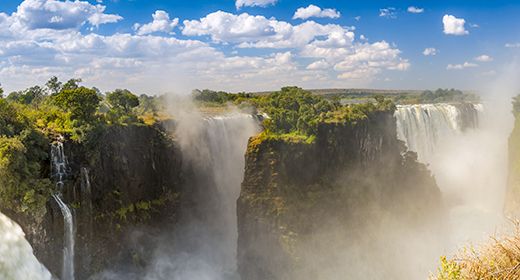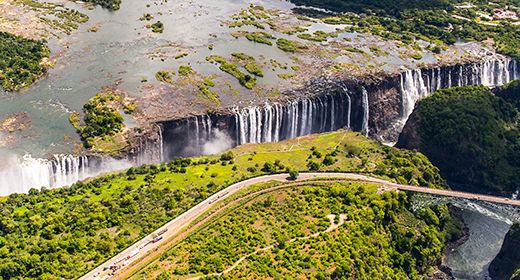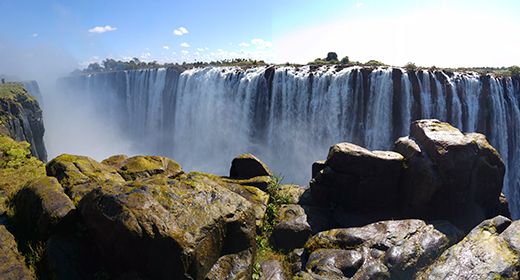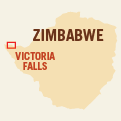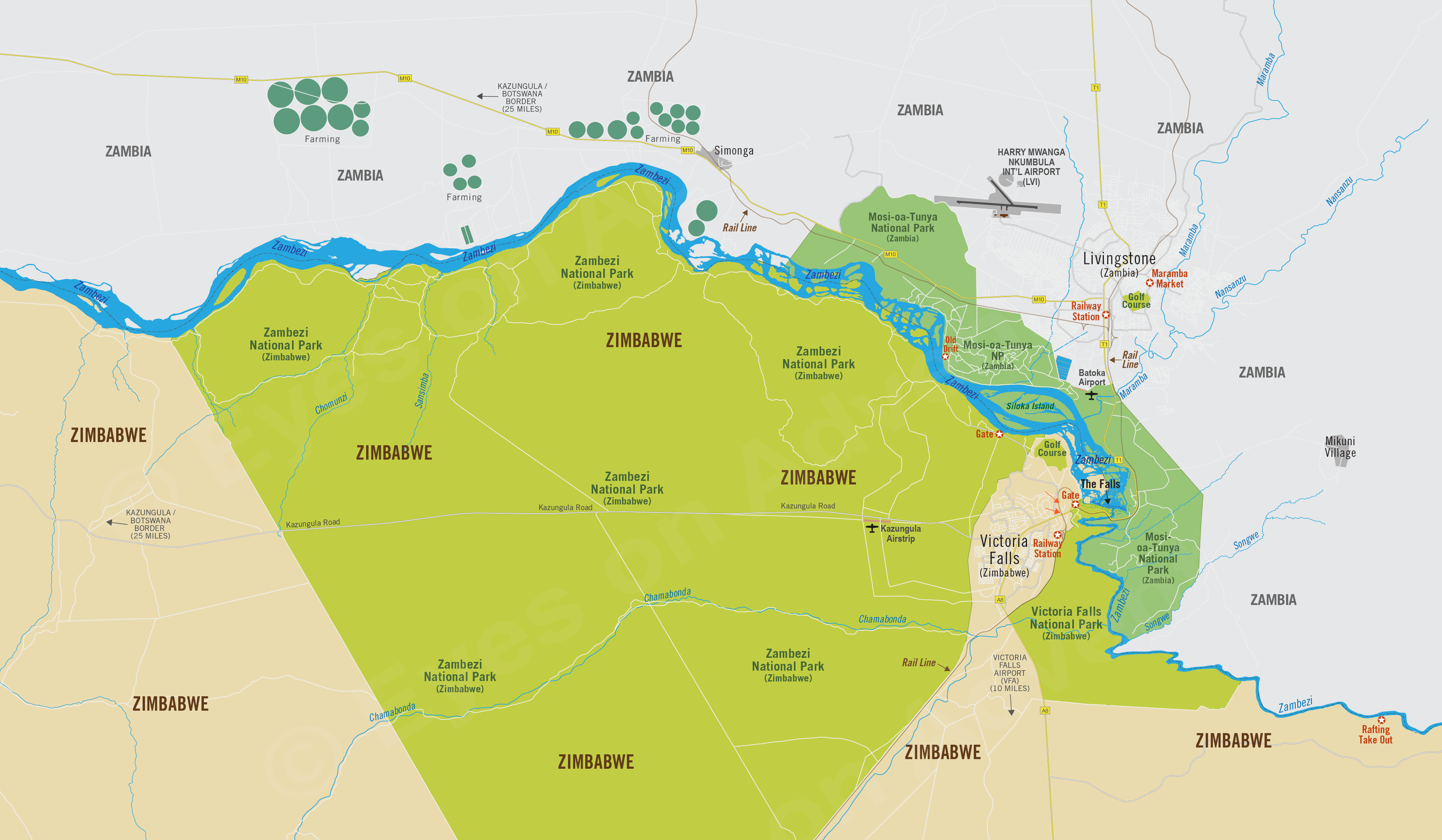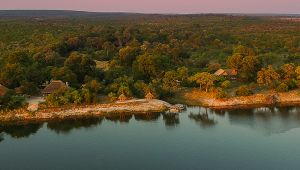Victoria Falls
(incl. Zambezi National Park, Victoria Falls National Park)
Region Links: Hwange, Lower Zambezi (Zimbabwe), Victoria Falls
Highlights
- Tour The Victoria Falls, one of the world's greatest waterfalls.
- Go white-water rafting in the spectacular gorges below The Falls.
- Canoe, cruise or fish on the beautiful Zambezi River above The Falls.
- Bungee jump off the Falls Bridge or take the Flight of the Angels overhead.
- Go on safari in the Zambezi National Park on the Zambezi River.
EOA Recommends: Matetsi River Lodge, The Elephant Camp, The Victoria Falls Hotel, Victoria Falls Safari Club, Victoria Falls Safari Lodge
Known locally as 'Mosi-oa-Tunya', meaning the Smoke that Thunders, The Victoria Falls are one of Africa's top destinations. The Falls are also renowned for adventure activities like white-water rafting.
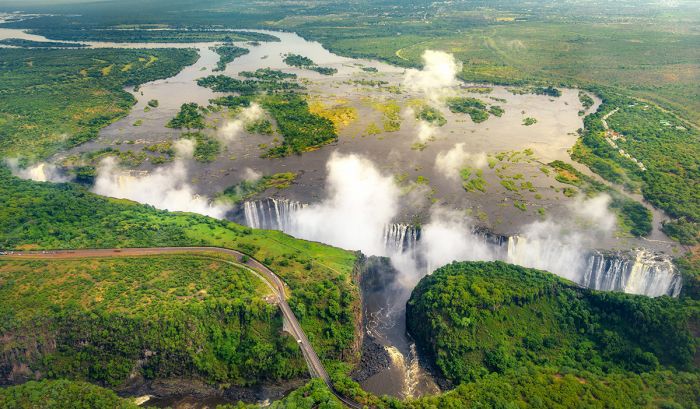
The Zambezi River flowing over the spectacular Victoria Falls.
The Falls are located on the lengthy Zambezi River, which marks the border between Zimbabwe in the south and Zambia in the north. An historic bridge dramatically spans the deep gorge below The Falls and connects the two countries by both road and rail. Visitors have the choice of staying on either side of the River, but many opt to view the waterfall on both sides to take in the complete setting.
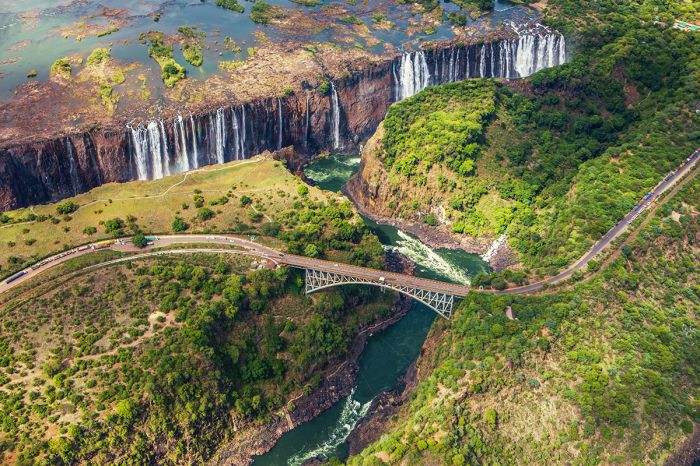
The Falls at low water.
The small towns of Victoria Falls (Zimbabwe) and Livingstone (Zambia) both offer roughly the same experience and are highly dependent on the tourism industry. Victoria Falls Town was long the choice for most tourists going back decades, but Zimbabwe's political unrest beginning in 2000 resulted in a shift to Livingstone. Many of the better lodges are located outside of the towns, along the river and in the national parks.
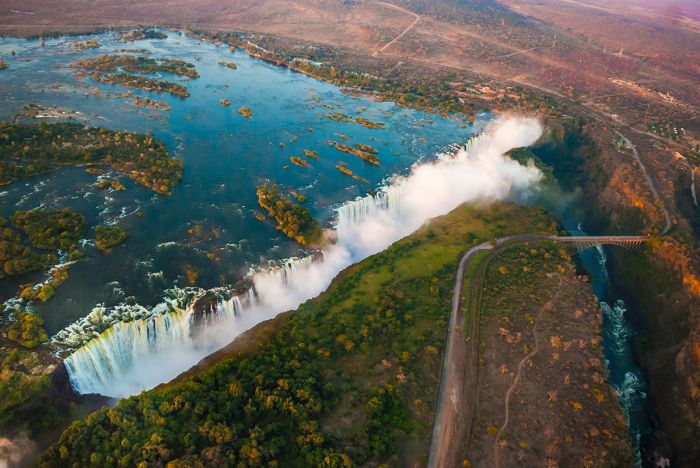
The Falls at high water with the "smoke that thunders" rising.
Seeing the Falls is most popularly done on walking trails located on the cliffs opposite the gorge on both sides of the river, but can also be done from above on a helicopter or microlight flight.
Adventure sports are the other big draw, especially white-water rafting in the gorges below The Falls. Other adrenaline-inducing activities include the bungee jump from The Victoria Falls Bridge (one of the world's highest commercial jumps), zip lining, canoeing, kayaking, canopy tours, the gorge swing, and more.
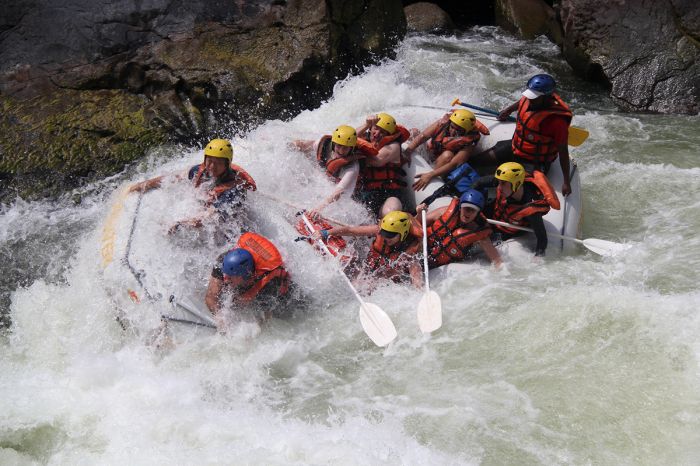
White-water rafting in the gorge below The Falls (copyright © Wilderness Safaris).
Game drives in the Zambezi National Park offer a chance to see wildlife like elephant, lion, leopard, buffalo, giraffe, hippo, crocodile, zebra, and more.
If you are planning to visit the Southern African region, including South Africa, Botswana, Zambia, or Zimbabwe, then adding a few days to see The Victoria Falls is something to consider, as it is logistically easy and a good way to diversify your adventure in Africa!
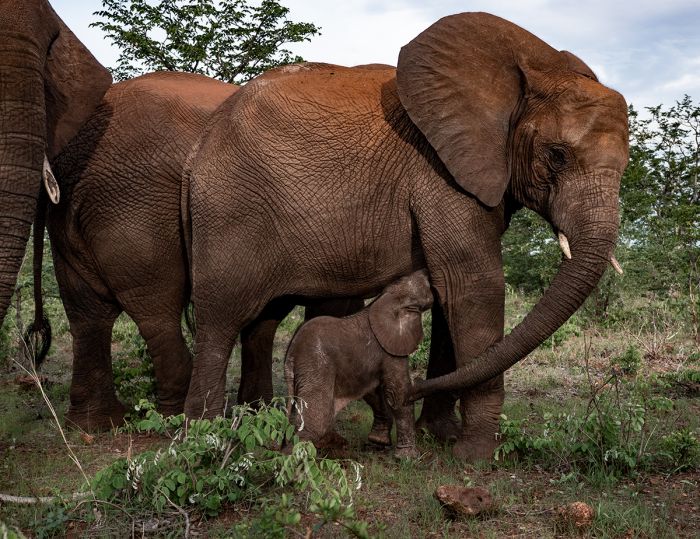
An elephant with her newborn calf in Zambezi National Park, Zimbabwe.
Read More...
Adrenaline Sports, Adventure Activities, Bungee Jumping, Canoeing, Devil's Pool, Falls Tour, Fishing, Flight of the Angels, Geological History, Gorges, Heritage Tours, High Water, Human History, Independence, Livingstone Island, Low Water, Markets & Shopping, River Cruises, Sights & Day Tours, The Victoria Falls, Victoria Falls National Park, Victoria Falls Town, Water Levels, White-Water Rafting, Zambezi National Park
Geological History
The Victoria Falls are located on the Zambezi River, which originates in the far northwest of Zambia, near the border with Democratic Republic of the Congo (DRC). The river flows immediately west into Angola, before turning south and back into western Zambia all the way to its southern border with Namibia's Caprivi region. From there it flows east, forming the Zambian border with Namibia and then Zimbabwe, where it flows over The Falls, continues east into Mozambique, and then continues southeast to the Indian Ocean.
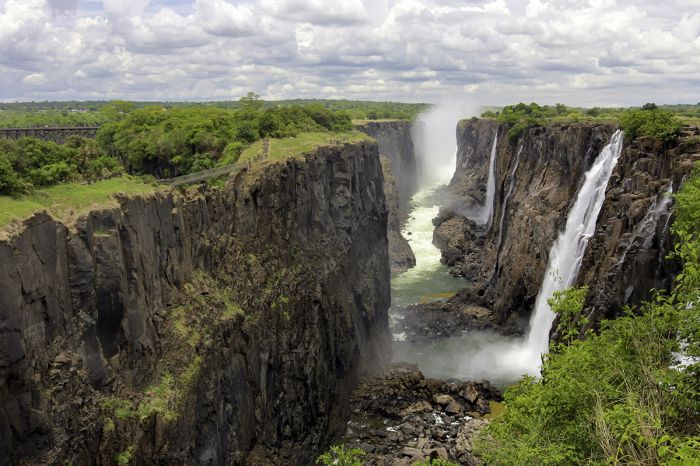
View of 1st Gorge from the Zambian side.
Millions of years ago, instead of changing course to the east at the present southern boundary of Zambia, the Zambezi River continued south into present-day Botswana and then into the Limpopo River, on Botswana's southern border. The Limpopo forms the present-day boundary between Botswana and South Africa and empties east into the Indian Ocean.
Then around five million years ago, an uplift of the terrain in Botswana's Kalahari changed the course of the Zambezi River, shifting it northeast, where it emptied into a basin, creating a massive paleo lake (Lake Makgadikgadi) in Botswana. The lake grew in size and existed for millions of years until, around twenty thousand years ago, when it finally overflowed its banks. The overflow formed a new river heading northeast, which joined waters from the Linyanti/Chobe river system. Eventually the middle Zambezi was formed with this new water.
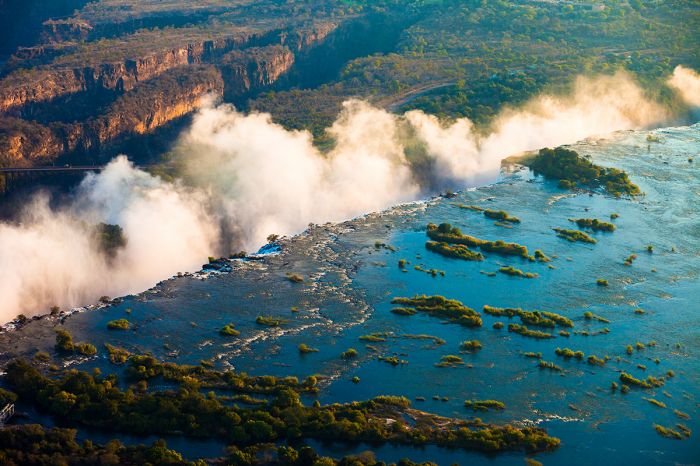
Thew "smoke" rising from the gorge.
The middle Zambezi River flows eastward onto a section of basalt rock (formed by volcanic magma), and over thousands of years, the river cut into this rock layer (which is 700-1000 feet/200-300 m deep) that was formed by volcanic activity around 150 million years ago.
Basalt is made from volcanic magma and is very hard, but fissures were formed in the rock when the magma cooled, creating faults in the rock. Because basalt is so hard, it does not erode gradually, but the flowing water of the river worked away at the weak cracks and gigantic blocks of rock eventually fell off, creating the Batoka Gorge and the The Falls.
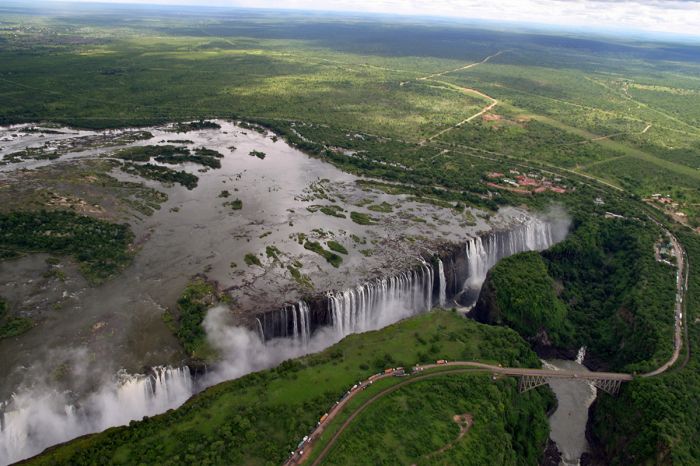
The Victoria Falls with the famous bridge connecting Zimbabwe to Zambia.
As the erosion of the basalt layer occurs, the location of The Falls eventually changes and moves upstream when new portions of the gorge are created wherever a massive portion of rock is caused to fall. Over time, there have been eight different positions for The Falls along the ever expanding gorge, with the oldest being the furthest downstream.
Excavations near the current waterfall show that they have only existed in this position for some 75 000 years. Eventually the current location of The Falls will change again to a new spot just upstream. Downstream from The Falls is known as the lower Zambezi River.
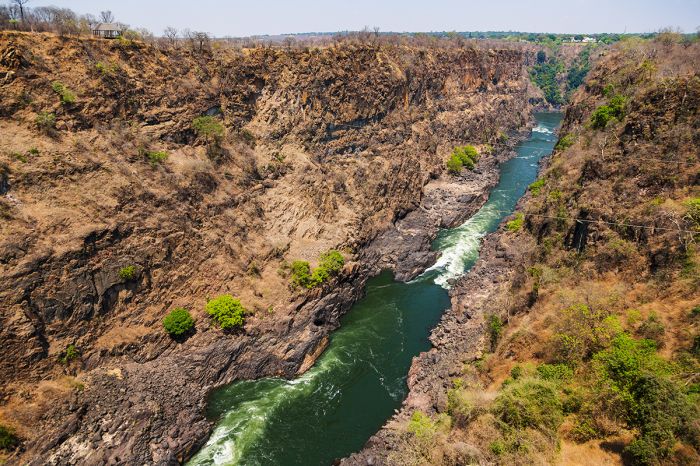
Second gorge below The Victoria Falls.
Human History
Fossil discoveries around The Victoria Falls and the Zambezi River indicate that our early ancestors inhabited this region going back 2 to 3 million years. Stone tools dating back 50 000 years also suggest that early hominids lived here throughout the Stone Age.
In more recent history, the hunter-gatherer people known today as the Khoisan, displaced or assimilated with the Stone Age clans about 2 000 years ago during the late Stone Age. Then in AD 400, the BaTonga (or Tonga) people, a Bantu-speaking tribe, began migrating to the region from the north, further assimilating with the Khoisan.
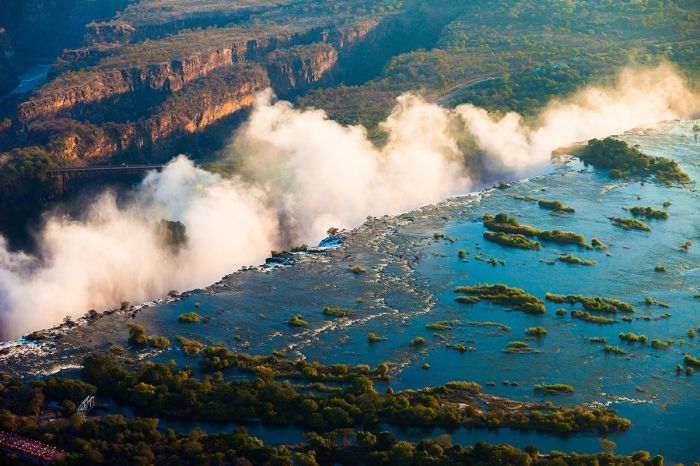
The "smoke that thunders" (spray) rising from the gorge below The Falls.
The descendants of these clans are still living in the Victoria Falls region today and are known as the Tokaleya or the Batoka people. Their language, "Tonga", in its various dialects, is the predominant local language spoken in the region. In the 1800s, displaced tribes from the south called the Matabele (Ndebele) and Makalolo also moved into the region.
The Scottish missionary David Livingstone is credited for naming The Victoria Falls and for the founding of the town. On one of Livingstone's African expeditions, this one to follow the Zambezi River from the interior to the coast, he was told by local Makalolo tribesmen about 'Mosi-oa-Tunya', which means 'the smoke that thunders'.
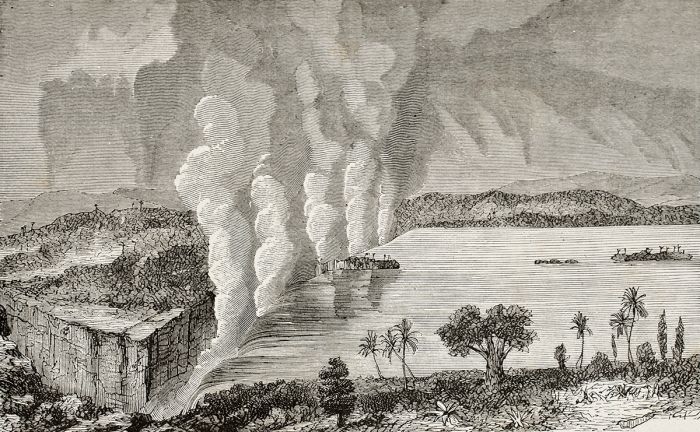
Illustration of The Falls from 1873 - artist unknown.
In November 1855, Livingstone arrived at the waterfall via dugout canoe with his Makalolo guides, declaring himself the first white man to set eyes on them. This claim is uncertain however, as the Portuguese had been trading in this area for decades. Nonetheless, it was Livingstone who reported the falls to Britain's Royal Geographic Society, naming them for the queen of Great Britain at that time.
Livingstone's famous quote describes his feelings on first seeing the falls: "No one can imagine the beauty of the view from anything witnessed in England. It had never been seen before by European eyes; but scenes so lovely must have been gazed upon by angels in their flight".
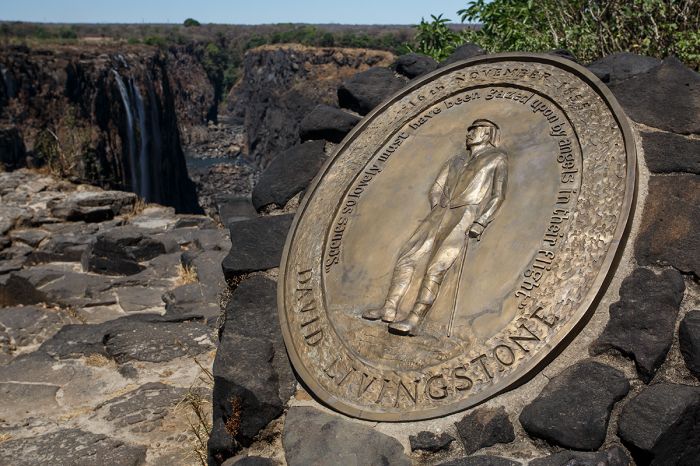
Memorial to David Livingstone at The Falls.
News of The Victoria Falls and the region brought numerous other explorers, big game hunters, and traders. Eventually, small settlement called 'Old Drift' was started on the northern banks of the Zambezi, just upstream from The Falls. River crossings were accomplished here using a tow-barge. The riverside settlement was later moved to higher ground in the location of present-day Livingstone, Zambia.
The first substantial settlement on the southern side of the river started around 1900 when workers for Cecil Rhodes' British South Africa Company (BSAC) arrived. Rhodes had struck deals with local tribal chiefs and secured the rights to minerals, elephant ivory, and timber on both sides of the Zambezi River in exchange for British protection.
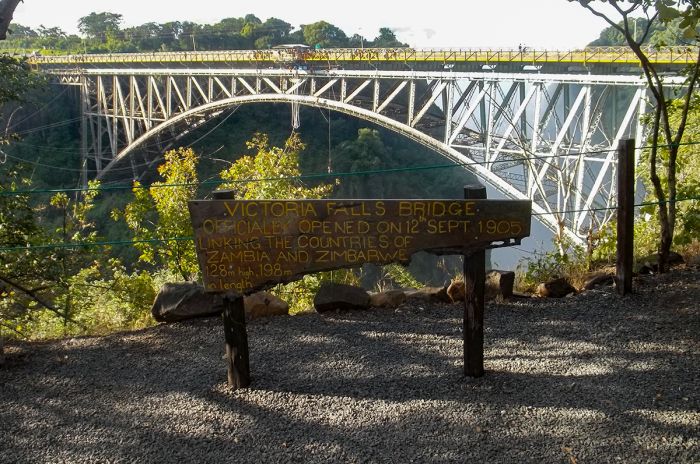
The Victoria Falls Bridge was first opened in 1905.
Rhodes' ambitions also included connecting the Cape of South Africa to Cairo, Egypt via a railway. Although he never visited The Falls during his lifetime, Rhodes decided to build the rail bridge over the Zambezi River in a most dramatic way, over the deep gorge below The Falls rather than at a simpler location upstream. The steel bridge was fabricated in England and shipped to Africa in pieces to be assembled on site. It took 14 months to complete and was opened in 1905.
Visitors began arriving by train to see The Falls, and although the more established town of Livingstone on the north side of the river was the focal point for arrivals to The Falls, the little town of Victoria Falls, which had mainly been occupied by BSAC employees, sprang up on the southern side.
Its first hotel, The Victoria Falls Hotel, was completed in 1904 as accommodation for the BSAC railway workers. Over its long history, this famous and glamorous hotel has been extended and refurbished numerous times, and is still in operation today.
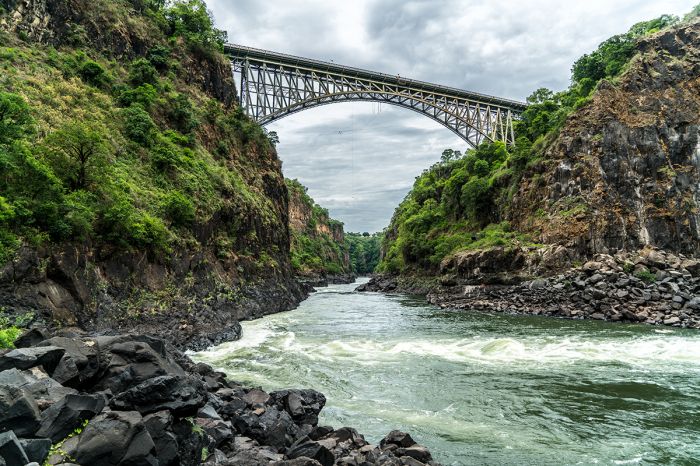
The Victoria Falls Bridge was completed in 1905.
In 1923, to solidify the BSAC's holdings south of the Zambezi River, Southern Rhodesia (today Zimbabwe) was established as a self-governing British colony.
In the 1930s, the British Empire began flying an airmail route from England to its colonies in Africa. The aircraft used were primarily the famous Short Solent flying boat (which landed on and was completely buoyant on water).
In 1948, Britain's newly formed state airline, the British Overseas Airways Corporation (BOAC), initiated a combined tourism/airmail round-trip flying boat service from Southampton, England to Vaaldam, South Africa. The route flew 2-3 times per week and, since there was no flying at night, the journey included overnight stops in Sicily, Luxor, Kampala, and Victoria Falls. For the stopover at Victoria Falls, the plane landed on a wide and open stretch of the Zambezi River, some 4 miles (7 kms) upstream from The Falls.
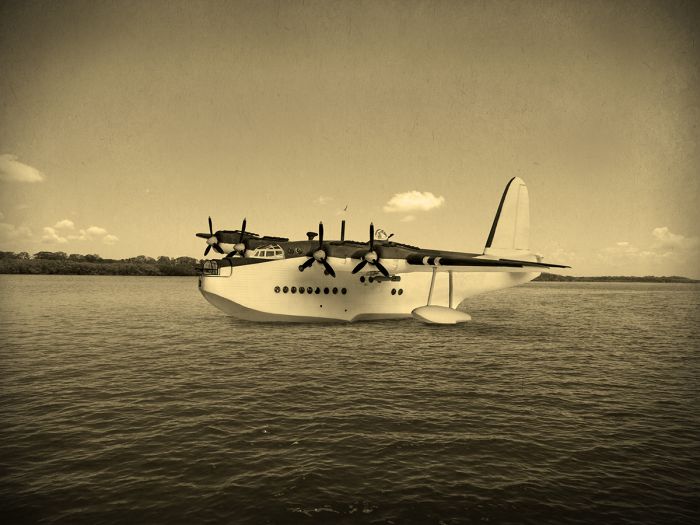
Early flights to The Falls were on a BOAC "Flying Boat".
The unpressurized aircraft had a crew of 7, with up to 34 passengers, plus cargo and mail, and had to be flown below 10 000 feet. Tourists disembarked onto a floating pier and were then transported to the very upmarket Victoria Falls Hotel. The flying boat service only lasted until late 1950, when Britain's new generation of pressurized aircraft replaced the flying boat and was able to complete the London to Johannesburg, South Africa flight (via the new Livingstone Airport) in just 35 hours.
It was in no small part due to these flying boat tours that the town of Victoria Falls became the focus for tourism at The Falls, shifting away from Livingstone town. In the 1960s, affordable airfares finally allowed more than just the wealthy to fly to see The Falls and it grew into one of Southern Africa's top tourist destinations.
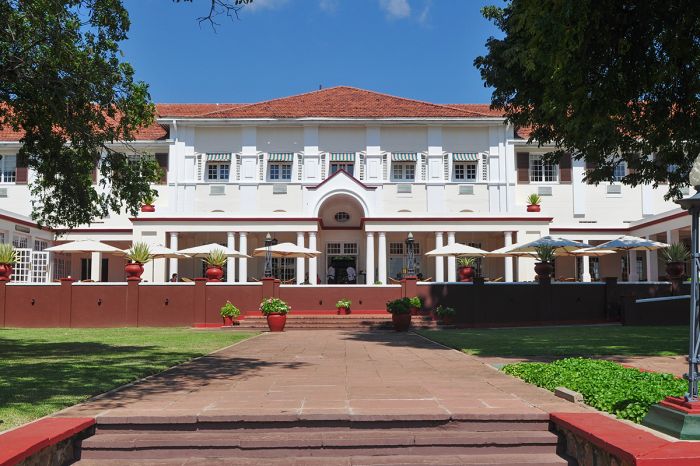
The historic Victoria Falls Hotel.
Independence
The land north of the Zambezi River and The Falls, known as Northern Rhodesia, gained its independence with black majority rule in 1964. Fearing the same transition to black majority rule in Southern Rhodesia (now simply called Rhodesia after Zambia's independence), Ian Smith's Rhodesian Front Party declared a Unilateral Declaration of Independence (UDI) from the United Kingdom. The UDI was condemned by most countries in the United Nations.
Civil conflict ensued with Joshua Nkomo's Zimbabwe African People's Union (ZAPU) and Robert Mugabe's Zimbabwe African National Union (ZANU) declaring guerrilla war on Rhodesia's white government. Both parties received active support from various communist powers and neighboring African countries, including Zambia.
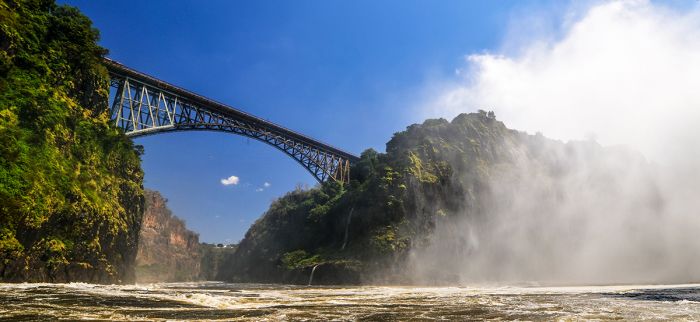
View of the bridge from the Zambian banks at "Boiling Pot".
In 1978, the intensity of the long conflict forced Smith to open negotiations with the militant opposition and in 1979, an accord was reached to hold elections in 1980, with Robert Mugabe becoming the first Prime Minister of the newly independent Zimbabwe. During the long years of the Rhodesian Bush War (1964-1979), The Victoria Falls Bridge was closed and tourism to The Falls understandably came to a halt.
After independence, tourism to The Falls was renewed and it became one of Africa's most visited destinations. Various operators began offering adventure activities like white-water rafting, bungee jumping, and flights over The Falls, which added to the destination's popularity.
The next 20 years brought substantial tourism growth to The Falls, with most visitors basing themselves on the Zimbabwe side in Victoria Falls town due to its much better infrastructure, including lodging and tour operators.
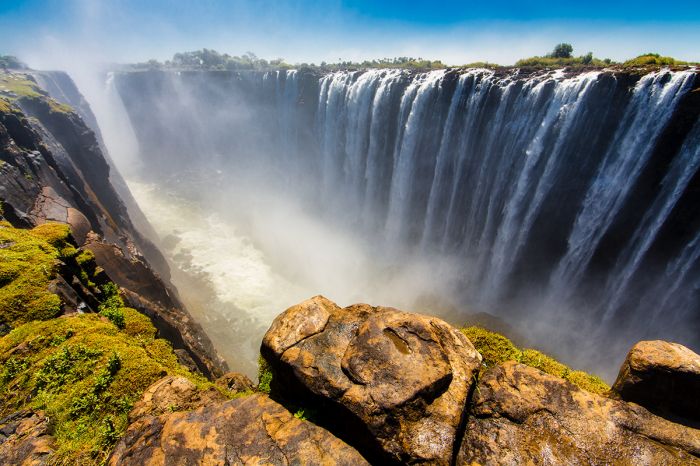
View of the gorge below The Falls.
Zimbabwe's tourism boom came to an abrupt halt in 2000, when civil unrest exploded in Zimbabwe. President Mugabe's new land reform policies resulted in violence when war veterans and local black Zimbabweans began forcibly removing white landowners from their properties (mostly farmers).
Global media coverage of the violence in Zimbabwe led to massive inflation and spreading fear amongst travelers, with tourism to The Falls shifting almost overnight to the Zambian side. The shift resulted in huge growth for Livingstone and although tourism has since recovered in Zimbabwe, the decade of unrest had a massive negative impact on Zimbabwe's tourism industry.
In 1989, The Victoria Falls were declared an UNESCO World Heritage Site.
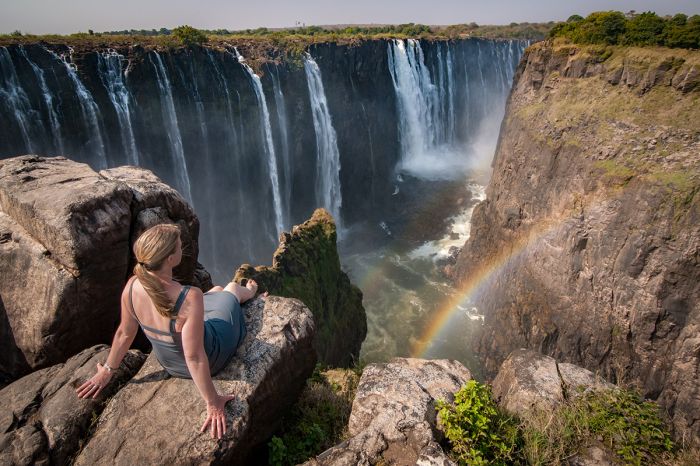
Viewing The Falls from Danger Point.
The Victoria Falls
The Victoria Falls are locally called 'Mosi-oa-Tunya', which in the Lozi language means "The Smoke That Thunders" and refers to the loud sound of the crashing water as it hits the bottom of the gorge and the rising spray that looks like smoke from afar.
The Falls measure 5 604 feet (1 708 meters) wide and 354 feet (108 meters) high, making it the largest single waterfall in the world. They are 1.5 times wider than Niagara Falls and twice as high. Only Brazil's Iguazu Falls are comparable in terms of the combined height and width of The Victoria Falls.
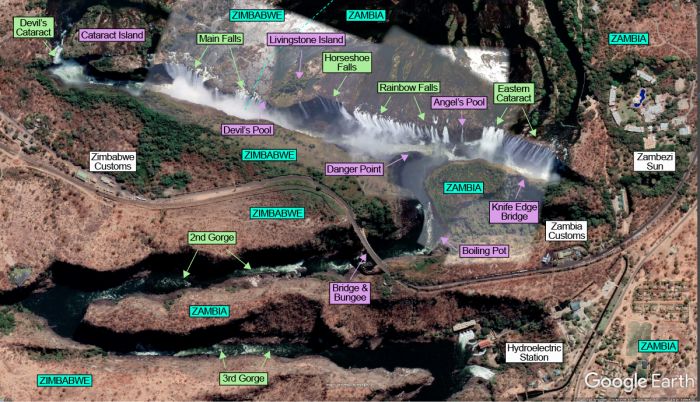
Important features of The Victoria Falls (copyright © James Weis).
Although their combined height and width arguably make The Victoria Falls the "biggest" of the world's waterfalls, in fact it is neither the highest (Angel Falls in Venezuela on the Kerepacupai Meru River), nor the widest (Khone Phapheng Falls in Laos on the Mekong River).
The border separating Zimbabwe and Zambia runs through the middle of the Zambezi River, both upstream and downstream of The Falls, so the waterfall and river are shared by both countries. In order to view both sides of The Falls, visitors must have a visa for both countries.
Upstream of The Falls for a distance of several hundreds miles, the course of the Zambezi River crosses a sheet of flat basalt rock, which was formed ages ago by molten magma. Over this part of the Zambezi's path, there are neither mountains nor deep valleys, only a flat and level plateau. As the river approaches The Falls, it widens and there are numerous islands that are covered in trees and other vegetation.
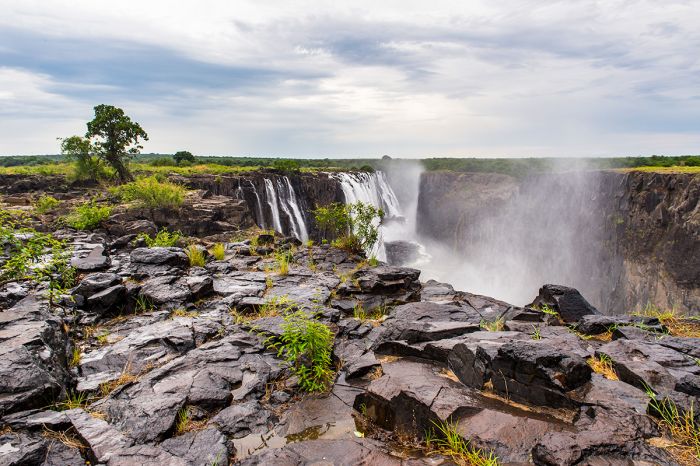
Looking east from Livingstone Island at the lip of The Falls.
At the lip of The Falls, there are two significant islands, each of which is big enough to separate the sheet of water as it flows into the gorge below. Livingstone Island, named for the spot where David Livingstone first viewed The Falls, is located roughly in the middle of waterfall, but on the Zambian side of the border. The much larger Cataract Island (also called Boaruka Island) is located very close to the Zimbabwe bank. When the river is at low water, there are many small islands, which are submerged at high water, that separate the waterfall into small streams.
At high water levels, the entirety of The Victoria Falls are comprised of five major and individually named sub-falls. Starting from the western bank of the river (the Zimbabwe side), the sub-falls are: the Devil's Cataract (between the western/Zimbabwean bank and Cataract Island), the Main Falls (between Cataract Island and Livingstone Island), Horseshoe Falls (east of Livingstone Island), Rainbow Falls (the highest of the falls), and the Eastern Cataract (on the eastern/Zambian bank).
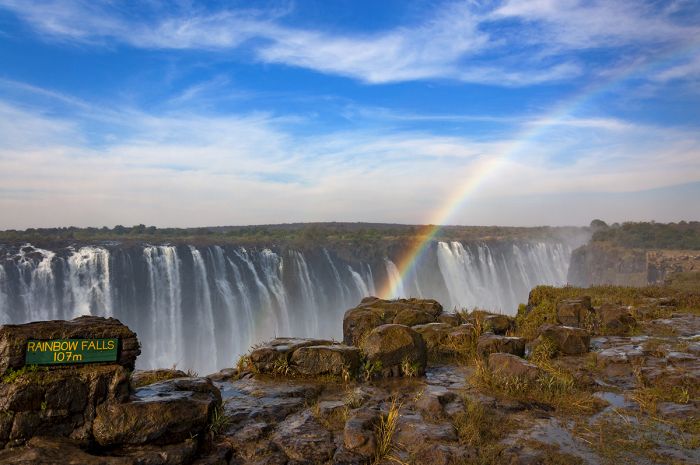
A rainbow appears through the spray at Rainbow Falls.
The Gorges
The series of gorges that have been cut out below The Falls are often called the Batoka Gorge. The position of the waterfall has moved over thousands of years, with eight historical positions. Currently, The Falls span the entire width of the Zambezi River, falling in a single vertical drop into the most recently created gorge, known as 1st Gorge.
First Gorge varies in depth from 260 feet (80 meters) on the western (Zimbabwe) side to 354 feet (108 meters) in the center. The river exits 1st Gorge via a 360-foot (110-meter) -wide opening one-third of the way from the eastern (Zambian) side and then flows through a series of zig-zag gorges, most of which represent past positions of the waterfall.
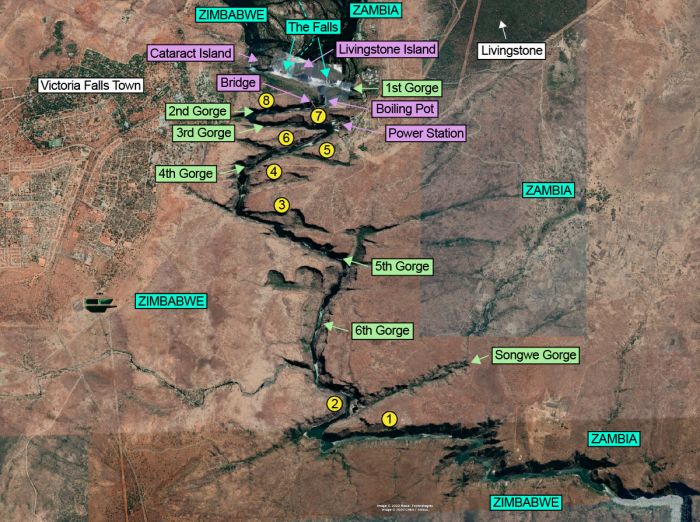
The Falls and gorges, showing prior waterfall positions (numbered 1-8) (copyright © James Weis).
During high water, a torrent of water rushes through the 490-foot (150-meter) exit cleft from 1st Gorge into 2nd Gorge, where it abruptly changes direction to the right, causing huge turbulence. The explosion of water at this point has, over many years, carved out a deep pool in the rock, known as "Boiling Pot". A steep trail (on the Zambian side) leads down to the gorge, where one can view the river up close. At low water, the pool is calm and some even swim here, but in high water, the water swirls and there are dangerously strong currents.
Just downstream from Boiling Pot is the famous and beautiful Victoria Falls Bridge and views from the bottom of the Boiling Pot Trail (Zambian side only) are very rewarding. Beyond Boiling Pot, the river gorges are arranged in a series of switchbacks and are named via number (1st Gorge, 2nd Gorge, etc.) in sequence based on the order reached by the river's flow.
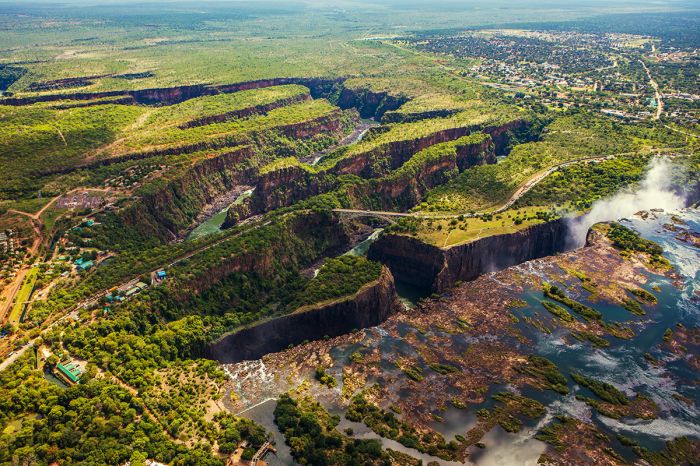
The Falls at low water and the gorges (Victoria Falls Town upper right).
Water Levels
Water levels in the Zambezi River and the volume flowing over The Falls fluctuate widely during the course of a year. The rainy season in the catchment area of the upper Zambezi occurs from late November until early April, with the remainder of the year experiencing little to no rain.
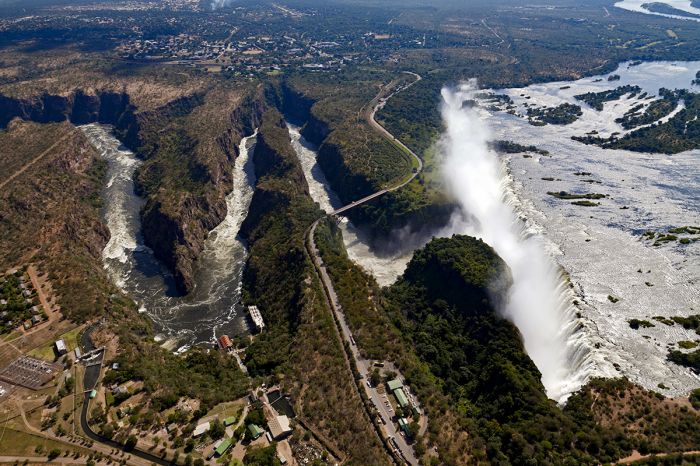
The Victoria Falls and Batoka Gorge at high water.
High Water
The high water levels reach The Falls between February and May, with the peak coming in March or April (dependent on the timing of rain in the catchment area and varying from year to year). The water levels and flow over The Falls gradually decreases from June until late November or early December, when the local rains at The Falls start replenishing the river.
At the peak levels during March/April, about 200 million gallons (750 million liters) of water flows over Victoria Falls every minute. At its lowest levels in October/November, the volume flowing over the waterfall can drop as low as 2.6 million gallons (10 Million liters) per minute. In terms of water volume, only the Iguazu Falls, which is located on the border between Brazil and Argentina, comes close to The Victoria Falls.
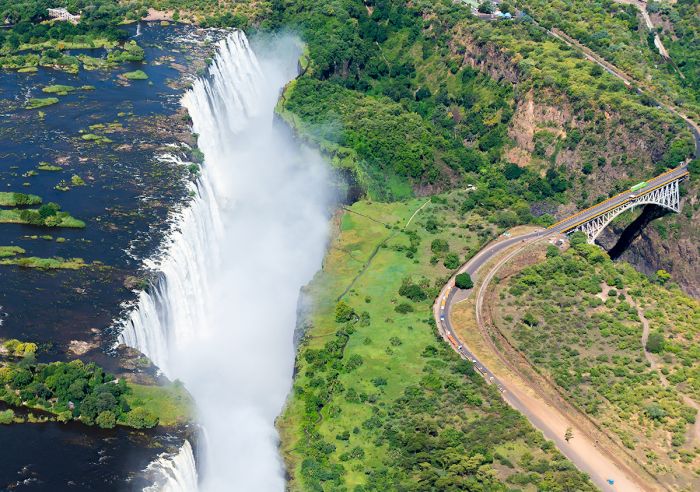
Huge spray rising from 1st Gorge at high water.
Another feature of high water at The Falls is the "spray" that is created as the incredible volume of water crashes into the gorge below. This water vapor is forced upward and often reaches a height of 1 300-2 600 feet (400-800 meters) above the top of The Falls and can be visible from a distance 30 miles (48 kms).
As the cloud of spray above The Falls condenses, it falls back down as rain, creating a very localized rain forest on the gorge cliffs opposite The Falls. Rainbows are created in this almost continuous rain (at high water only) and on nights with a full moon, a lunar rainbow (or "moonbow") can be seen.
The walking path along the gorge cliff and through the small rain forest on the Zimbabwe side allows views of about three-quarters of the entire width of The Falls; however, at high water, the huge cloud of spray rising from the gorge almost totally obscures any views of The Falls themselves.
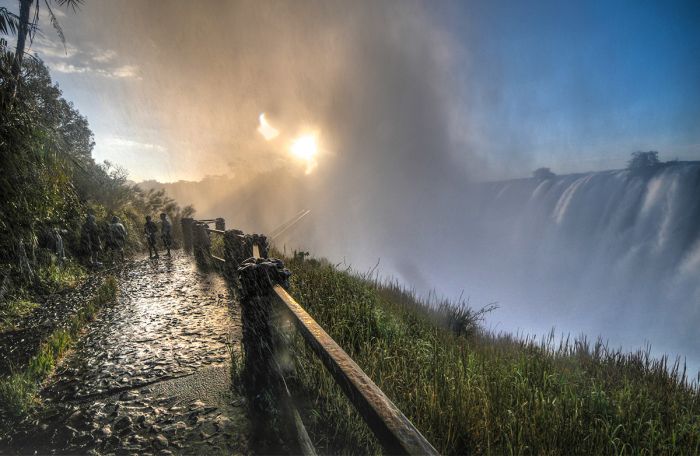
The spray rising from the gorge (note everyone wearing rain gear).
Low Water
After the peak water levels in March/April, the flow and water levels in the Zambezi begin steadily declining from June until November. The lowest water levels are in October and November, when most of the channels to the east of Livingstone Island all the way to the Zambian bank become small trickles of water. Most of the river flows down the falls at Devil's Cataract and Main Falls. The water nearest the Zambian bank may even dry up completely.
Although many visitors prefer to "see" The Falls at high water so they can experience the incredible thunderous noise and spray, visits during low water are rewarding, albeit in a different way. Walking out into the nearly dry river from the Zambian side gives fascinating looks at the spectacular rock structures underlying The Falls and the gorges downstream are more revealed. The popular "Devil's Pool" activity is only available during low water.
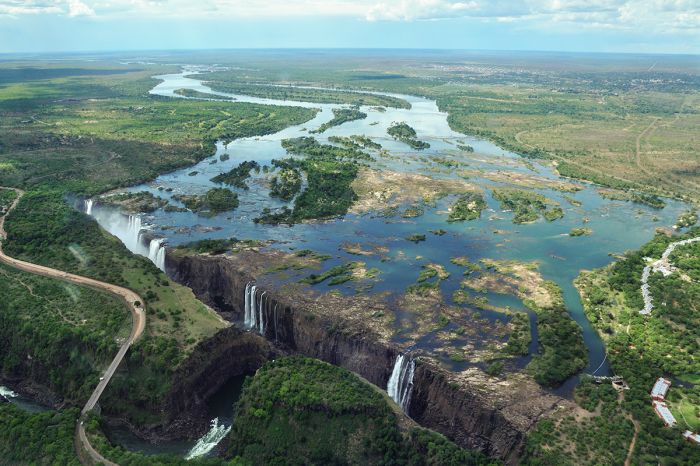
The Victoria Falls at low water with the Zambian side totally dry.
Sights & Day Tours
Walking Tour of The Falls
The foot path on the cliff opposite The Falls is much more extensive on the Zimbabwean side than that on the Zambian side, providing numerous viewpoints right along the edge of the precipice and routes winding through the small rainforest. A memorial statue of David Livingstone stands at the far western side near Devil's Cataract. The Victoria Falls National Park protects the entirety of the path and cliffs.
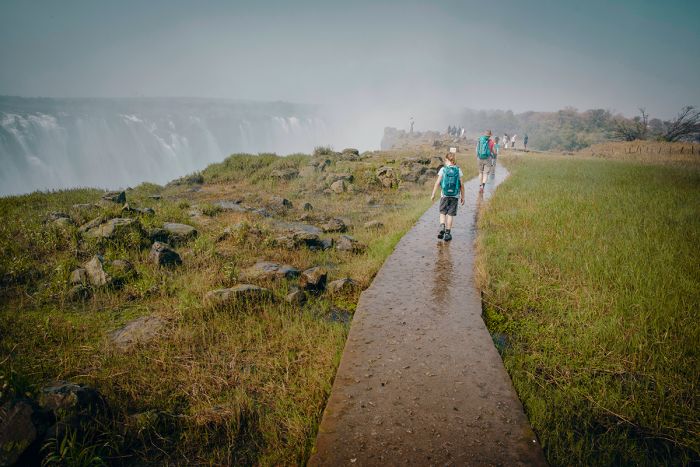
Walking on the cliff opposite The Falls.
Walking can be done on your own or with a knowledgeable guide that can be hired at the Park Gate / Visitor's Centre. Cheap raincoats can be purchased at the kiosks in the parking lot, as one can get wet, even in the dry season. Be sure to protect your camera from the mist and rain.
The rain forest evolved due to the near-constant mist and rain created by the spray rising from the gorge below. Depending on the season and water levels, the humidity here ranges from a sparse mist at low water to a drenching rainfall and all encompassing fog at high water. The forest has evolved over thousands of years into a unique ecosystem, with dense foliage, trees, creepers, flowers, and vines. There are animals such as bushbuck and also good birding in this small but beautiful forest.
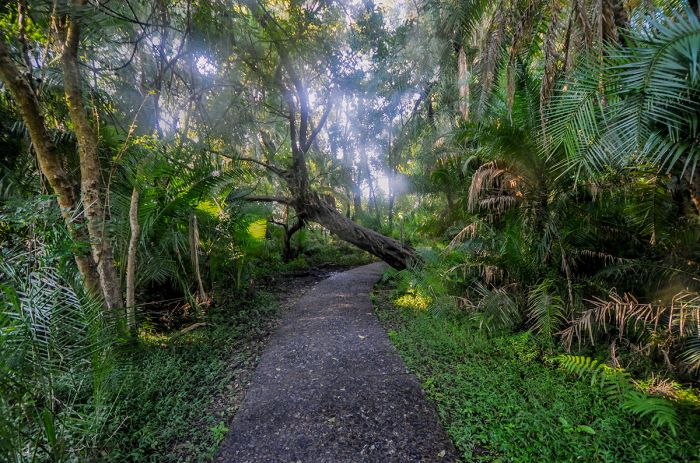
The walking path through the rain forest.
Livingstone Island
The famous island where David Livingstone camped and had his first views from the lip of The Falls in 1855, is situated on the Zambian side of the border (which runs just west of the island), but you can tour the island even if staying on the Zimbabwe side. The tours are led by Tongabezi Lodge and they will transport you across the bridge, thru customs, and to their boat launch, where a short speed boat ride brings you to the island.
The tours operate multiple times per day (with different meals or snacks depending on the tour) between July and March and subject to water levels. The trip includes a guided walking tour of the island, refreshments, and snacks or a meal. During low water (typically mid-August to late December), you have the adrenaline-filled option of swimming out to Devil's Pool, where you can peer over the edge from the world's most incredible infinity pool (see more below).
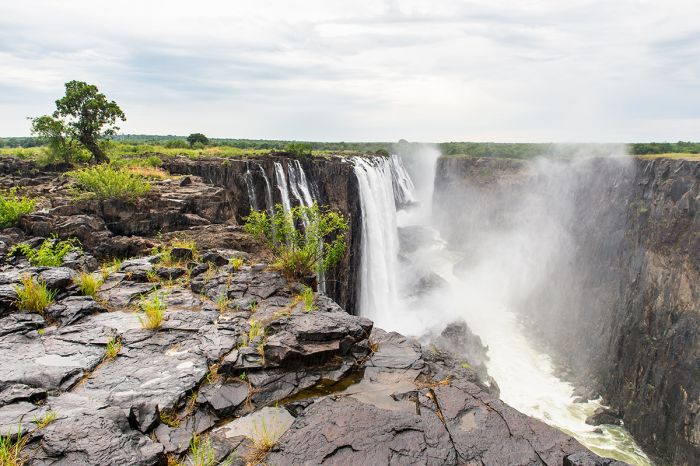
The view from Livingstone Island at the lip of The Falls.
River Cruises
There is no shortage of options for boat cruises on the Zambezi River above The Falls. The sunset cruises are by far the most popular, but there are departure options throughout the day, with most tours leaving near the A'Zambezi Lodge.
Most cruises include some level of catering, but the style and options vary greatly from double-decker luxury riverboats with Champagne and upscale dining to small island hoppers with picnic lunches. Some of the sunset cruises include live music. Pre-book with us or check the brochures at your hotel and book on site.
Don't forget to bring your camera and binoculars as you are likely to see wildlife along the banks, including hippos, elephants, crocodiles, buffalos, various antelopes, and lots of birds.
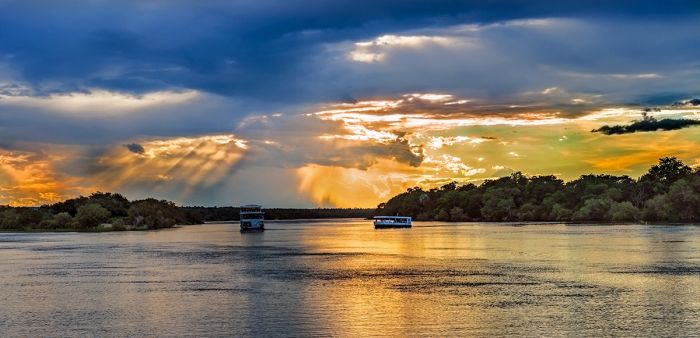
Sunset cruising on the Zambezi River above The Falls.
Fishing
There are several operators that offer fishing excursions on the river upstream from The Falls. The tiger fish is a favorite among anglers worldwide, but there are over 100 species of fish in the Zambezi and other likely catches include bream and catfish. Half-day and full-day outings are available and outfitters will supply you with a knowledgeable guide and all the fishing tackle needed, as well as food and drinks.
Multi-day fishing trips are also possible and these can be spectacular, with the boats heading far upriver and offering much better fishing. The best months for fishing are typically May thru September.
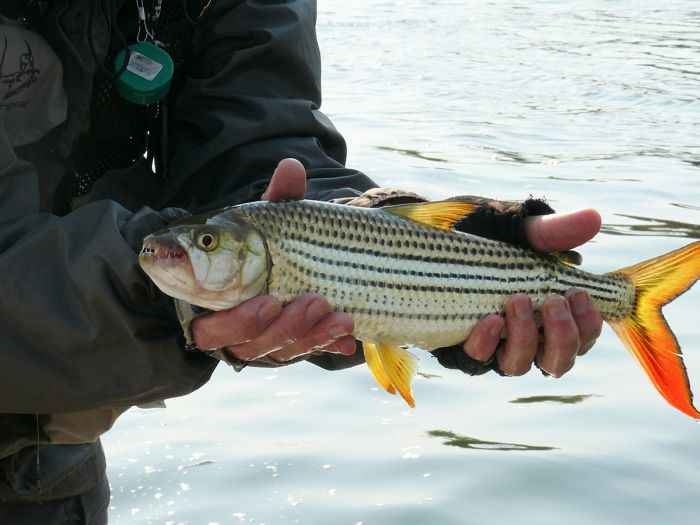
Tiger fishing is a popular activity on the upper Zambezi River.
Markets and Shopping
Victoria Falls Town has plenty of retail shopping and there is seemingly no end to the local curio sellers that are around every turn as you get closer to The Falls. Tourism supports a huge number of residents in the town, so be prepared to be approached to buy wood carvings, small curios made from various recycled materials, t-shirts, paintings, hand-made jewelry, local fabrics, and more.
There are also some upscale retail shops selling more authentic and upscale artworks including African masks, jewelry, drums, woven baskets, wood and stone carvings, and more. Bargaining is always expected. Some of the local operators include market visits on their historical or town tours.
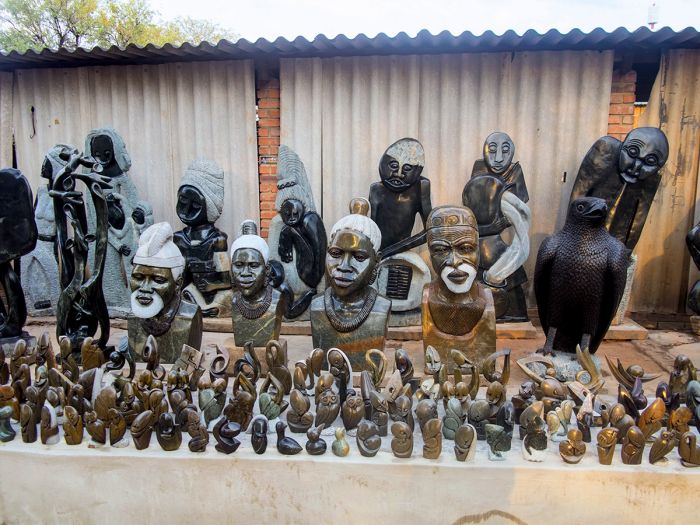
Stone carvings and other curios are offered at numerous markets.
Heritage Tours
A few operators host what are termed 'heritage tours' that are generally booked on a private basis and include a guide/storyteller who will give presentations and lead a walking tours of town, The Victoria Falls Bridge, and/or the waterfall.
Presentations may focus on David Livingstone, the history of the town, colonialism, the formation of The Falls, the construction of the bridge and other historical information. These are an excellent way to learn more about this fascinating region.
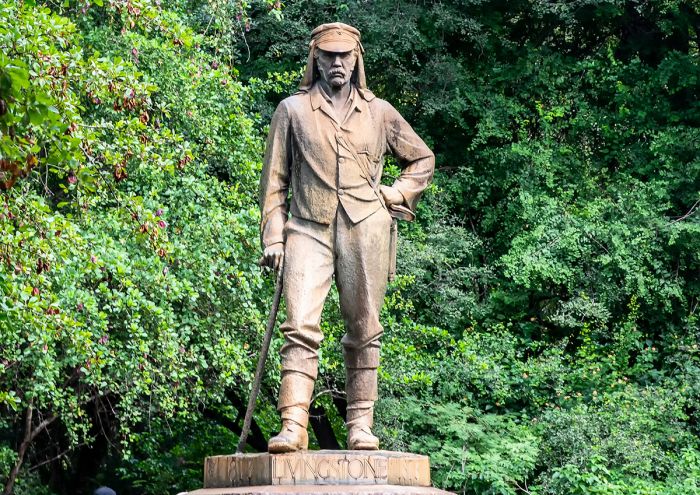
Statue commemorating David Livingstone at The Victoria Falls.
Adventure Activities
The Victoria Falls on both the Zimbabwean and Zambian side of the Zambezi River is certainly the adventure capital of the entire Southern Africa region.
Operators in both Victoria Falls town and Livingstone (Zambia) offer an array of adrenaline activities including bungee jumping (off The Victoria Falls Bridge), white-water rafting below The Falls, gorge swinging, kayaking, abseiling, zip lining, canoeing (both above and below The Falls), flights over the waterfall (helicopter and microlight), and many more.
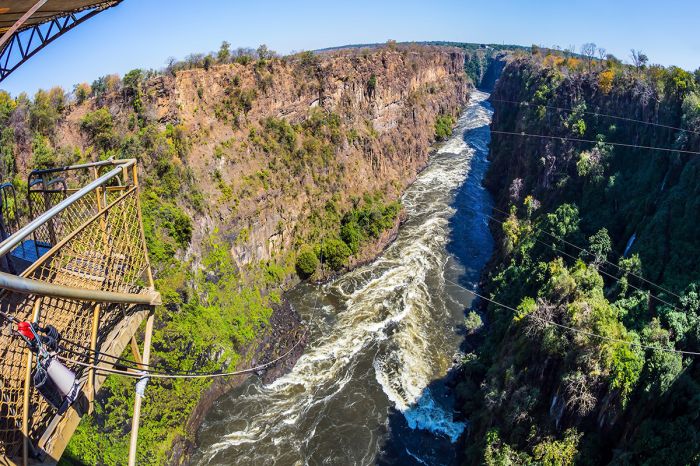
The view from the Victoria Falls Bridge bungee jump platform.
White-Water Rafting
The pioneer activity for all adventure sport at The Falls was white-water rafting through the gorges below The Falls. The rapids starting at Boiling Pot (just below The Falls) are numbered from 1 to 23 and most of them are graded as Class 4 or 5 (class 6 is the highest on the scale and considered commercially infeasible).
This series of rapids in one of the most dramatic settings in the world, is undoubtedly something not to be missed for anyone that loves adventure. Even though the level of these rapids might at first seem to be a deterrent, no level of experience is required to enjoy them, as expert guides will steer the boat over the rapids. There are long stretches of calm water between most rapids, giving you time to enjoy the scenery in the deep gorge.
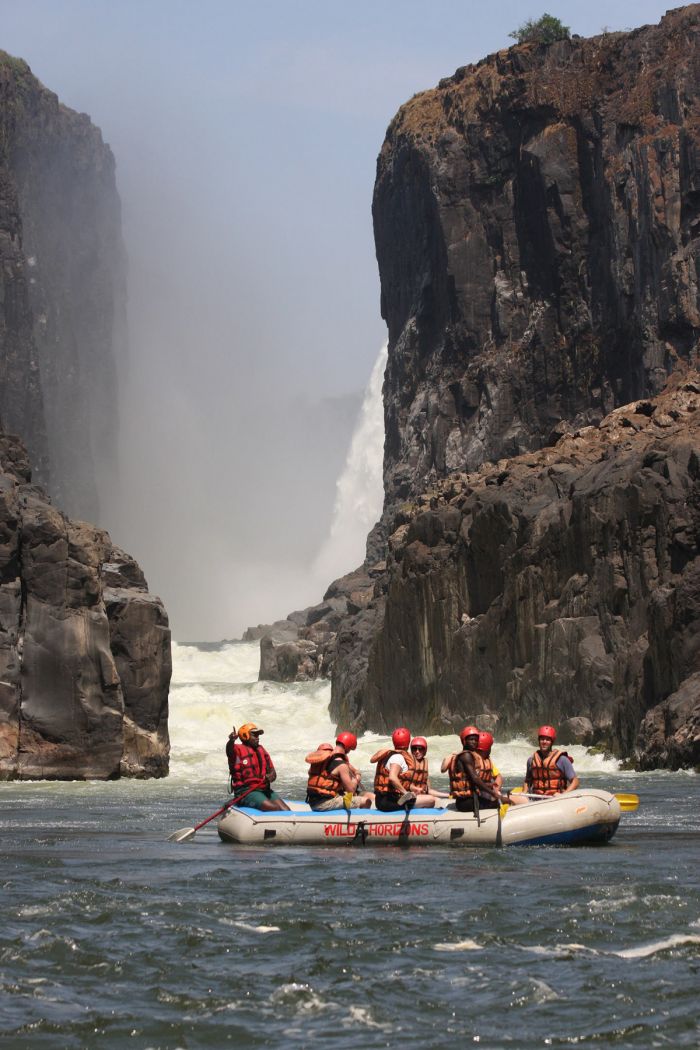
White-water rafting starts just below The Falls (copyright © Wild Horizons).
Rafting trips are broadly differentiated and a totally different experience based on water levels in the river (low water or high water). The seasons are determined by rainfall and are never exactly the same year to year (see above for more on water levels).
Rafting trips are offered on both sides of the river, but starting from the Zambian side begins at Boiling Pot and all rapids are included, while trips departing on the Zimbabwe side start above Rapid #4.
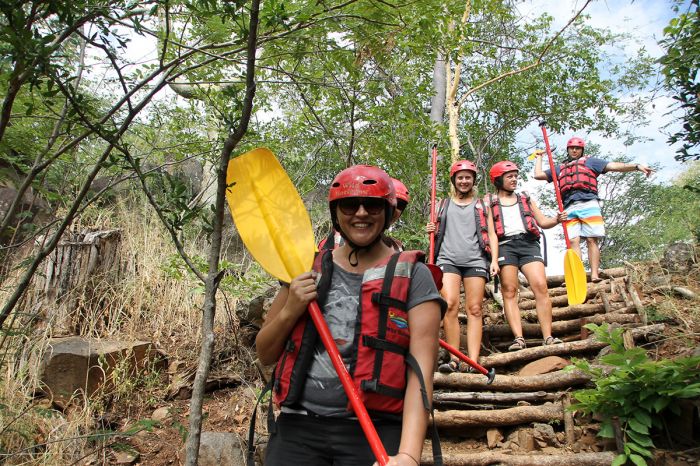
Rafters hiking down into the gorge (copyright © Wild Horizons).
Low-Water Rafting
The low water season generally runs from mid-July or August into late-December or mid-January and this is the season most people prefer, as it offers the most dramatic rapids. The lower water levels make for a more exciting trip, with lots of white-water rushing over the exposed rocks, causing high waves and deep troughs.
All 23 of the rapids are available during low water, with Zambian trips embarking from Boiling Pot just below The Falls and Zimbabwe trips starting above Rapid #4 (high water trips skip the first 9 rapids due to the higher risk).
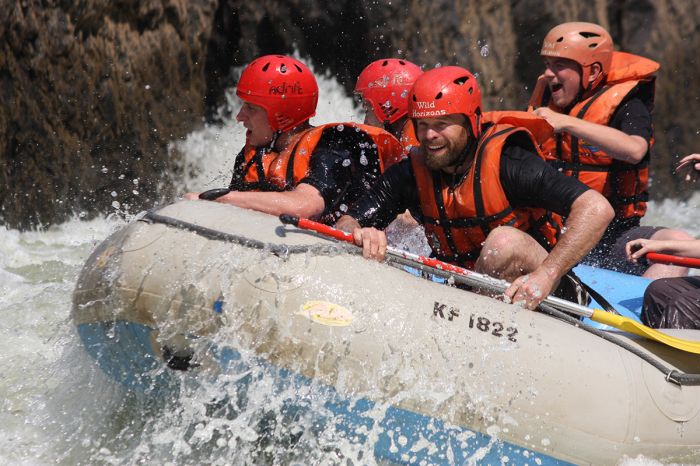
The rapids are at their best during low water (copyright © Wild Horizons).
Full and half-day trips are available, both starting off at around 8am. Half-day trips exit the river at Rapid #19, with a steep climb to the top of the gorge for a picnic lunch, finishing around 2-3pm.
Full-day trips finish after Rapid #23, finishing late afternoon with a stop along the river for lunch. Multi-day trips are also offered, covering 5 to 7 days, with multiple portages , camping along the river each night, and the possibility of rafting all the way to the Matetsi River mouth.
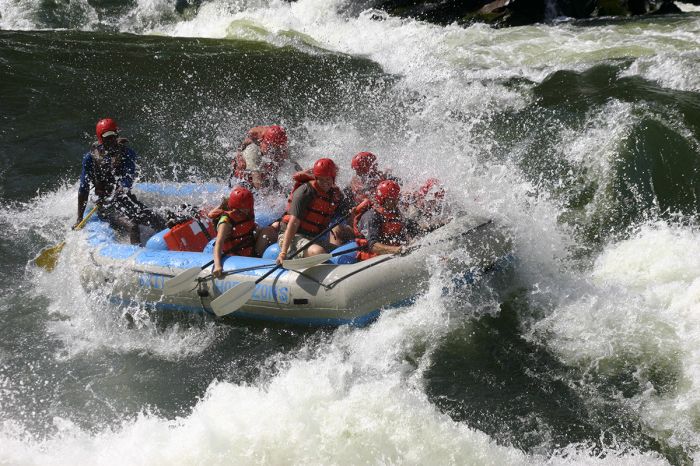
Low water is best for dramatic rapids (copyright © Wild Horizons).
High-Water Rafting
Trips departing during high water (generally February to July) are shorter, with trips from both sides of the river beginning after Rapid #9, which is too dangerous and is always a walk-around/portage even at low water.
In high water, many of the bigger rapids are less dramatic, with less white water and fewer exposed rocks, but in fact the river is more dangerous due to the stronger undercurrents and swirling water. When the river becomes especially high (usually from March thru May), all rafting operations are postponed.
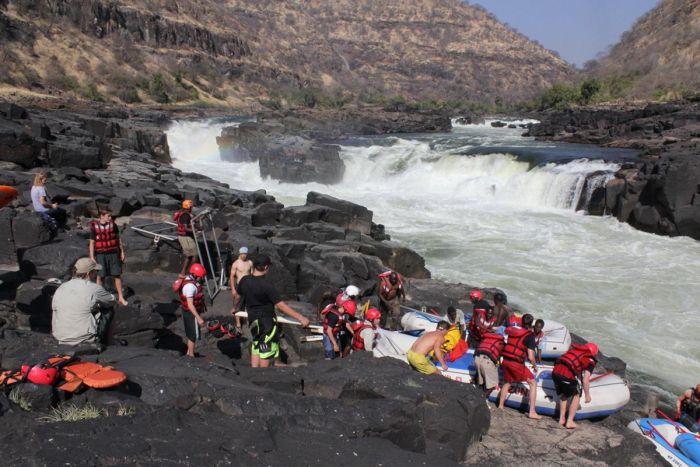
Rafters have to portage around Rapid #9 (copyright © Wild Horizons).
Rafting Options
Besides for rafting seasons/time of year, the other option is choosing between two styles of rafting trips: Oar Boat and Paddle Boat.
Rafting in an oar boat is the easier and less active (although still exciting). Participants in an oar boat basically just hang on and shift their weight around by leaning left, right, or forward on command, as instructed by the guide, who does all the navigation by himself with his own paddle at the rear of the raft. This is certainly the safer option, with far less risk of falling overboard.
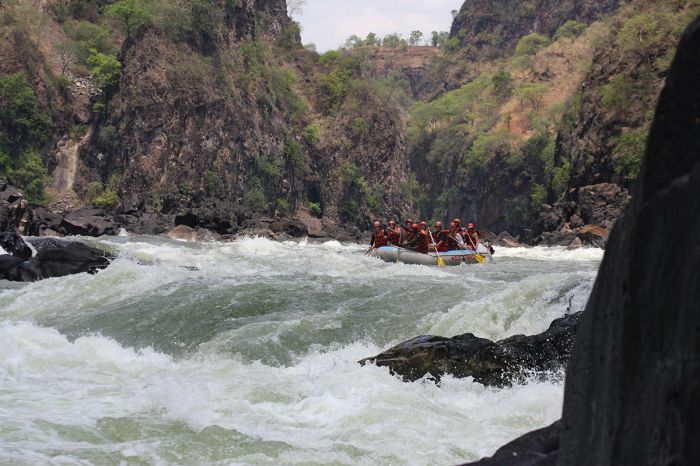
The Paddle Boat option means all passengers are active paddlers (copyright © Wild Horizons).
The paddle boat style of rafting involves every passenger having their own paddle and providing the acceleration and some steering. This is by far the more exciting style, but because passengers are paddling, it is much more difficult to hold on and the risk of taking a swim is much greater!
Successfully navigating the rapids on a paddle boat is largely dependent on the group following instructions immediately and paddling vigorously on command. Every rafter is an active participant rather than just a passenger, making paddle trips much more strenuous and thrilling.
All trips require participants to wear helmets and floatation jackets, but capsizes and falling overboard is always possible, which is after all, part of the excitement that makes these trips so thrilling!
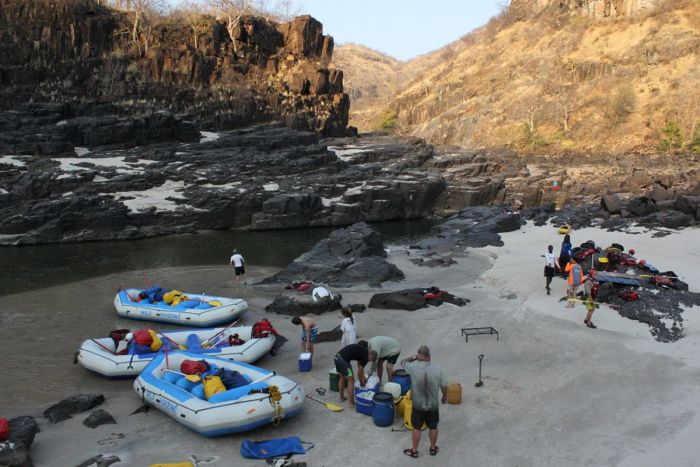
Multi-day rafting trips are an exciting adventure (copyright © Wild Horizons).
Devil's Pool
One of the most popular adrenaline activities at The Falls is the Devil's Pool. Open only during low water from mid-august to late-December or mid-January (October and November are best), this adventure involves a short swim from Livingstone Island to a natural rock depression located at the precipice of The Falls, where participants can sit safely and even peer over the rim to the gorge below.
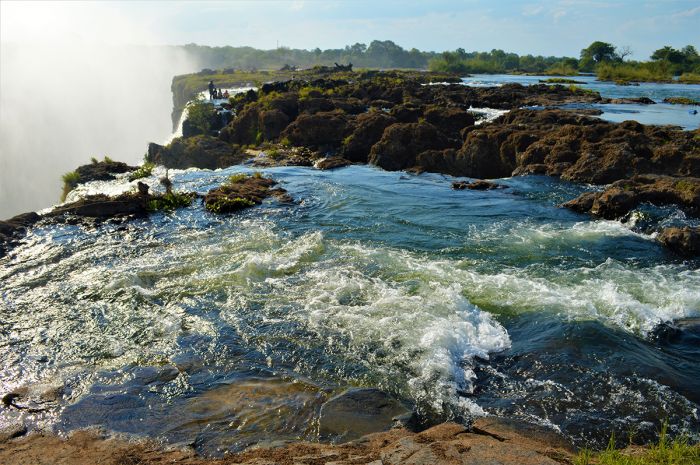
Tourists in the Devil's Pool during low water (image taken from Livingstone Island).
The rock at the rim of The Falls creates a pool that can be entered by a small group of people (with experienced guides) where the flow of river water is very limited, allowing everyone to swim and enjoy the amazing feeling of being at the edge of the waterfall.
During months where the Devil's Pool is closed (it is unsafe once the water levels rise), a second, but much smaller pool called Angel's Pool is an option. Angel's Pool is also accessed from Livingstone Island, but is on the other side and is reachable safely from April/May thru September.
Both Devil's Pool and Angel's Pool are accessed only from the Zambian side of the river, but visitors staying on the Zimbabwe side can easily do this activity. Participants are picked up at their hotel, transferred by vehicle over the bridge into Zambia (where a visa is obtained), and driven to the boat launch at Tongabezi Lodge.
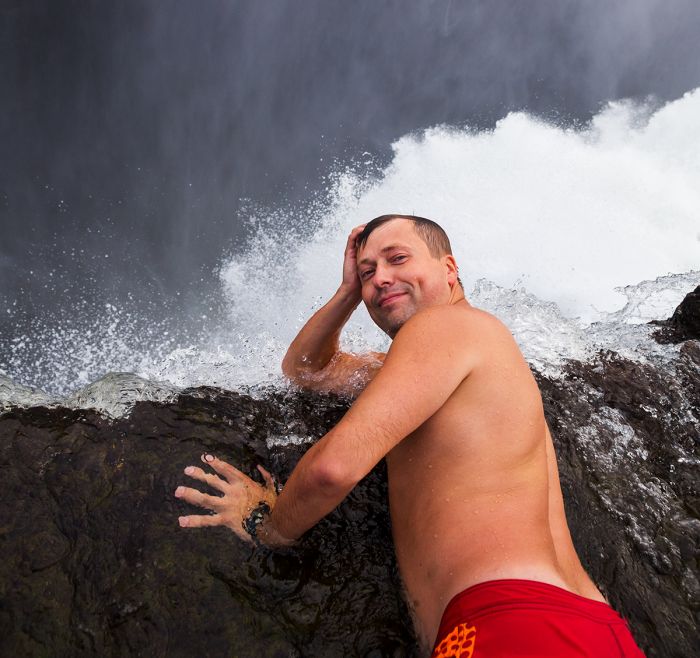
Lying along the precipice of The Victoria Falls in Devil's Pool.
Canoeing
Several operators offer canoe trips on the calm waters of the upper Zambezi (above The Falls). This is the territory where David Livingstone spent several days canoeing and exploring before reaching the waterfall. Trips of various duration are available, some where you simply sit back while the guide does all the paddling and some where you are an active paddler. No prior experience or skills are needed.
Canoeing is offered as a sundowner trip or during the day. Most of the time you will explore along the Zimbabwean bank, which is the Zambezi National Park and you are sure to see wildlife, so bring your camera and binoculars. Wildlife you can expect to see includes hippo, crocodile, buffalo, elephant, various antelopes, and plenty of birds life.
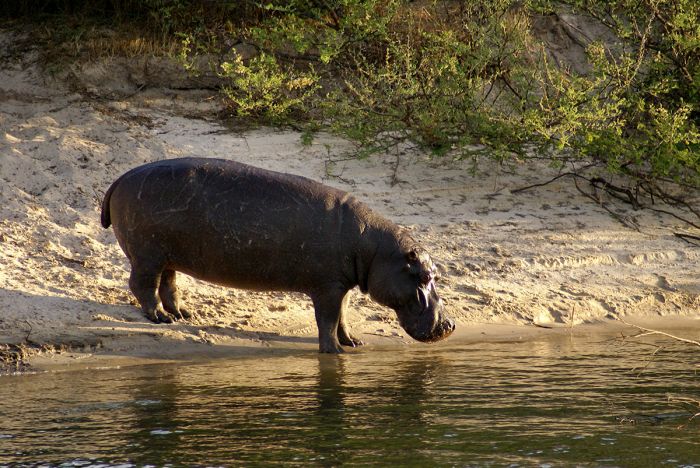
Canoeing on the upper Zambezi will provide some wildlife sightings.
Bungee Jumping
Certainly one of the most daring of all the adventures offered at The Falls is the bungee jump from the middle of The Victoria Falls Bridge into the deep canyon below. Those who dare will leap off the bridge and free fall 364 feet (111 meters) towards the Zambezi River before coming to a halt just above the water and bouncing back up again. Afterwards, you are winched back up to the bridge.
The activity is one of the world's highest commercial bungee jumps and is one of the most intense experiences imaginable. Tandem jumps are available. During the rainy months (November thru May), interruptions in the activity can be expected, as the bungee cords must be dry for safety.
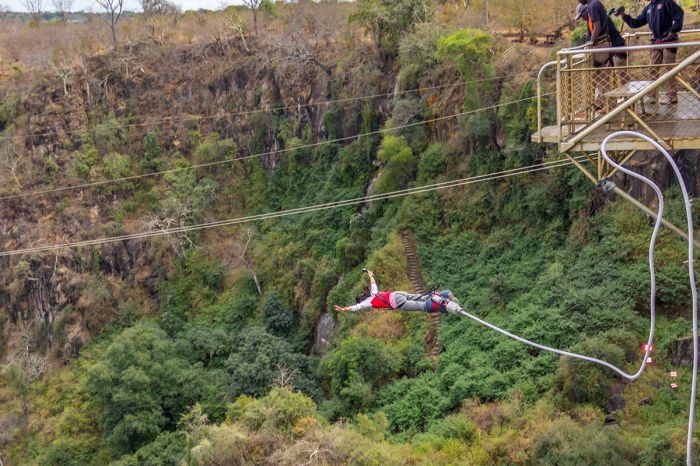
A bungee jumper launches off the Victoria Falls Bridge.
Flight of the Angels
One of the best ways to take in the entirety and immensity of The Falls is on a helicopter or microlight flight above the waterfall, river and gorges. These flights are commonly known as "Flight of the Angels", referring to the well-known quote written by David Livingstone in his description of The Falls.
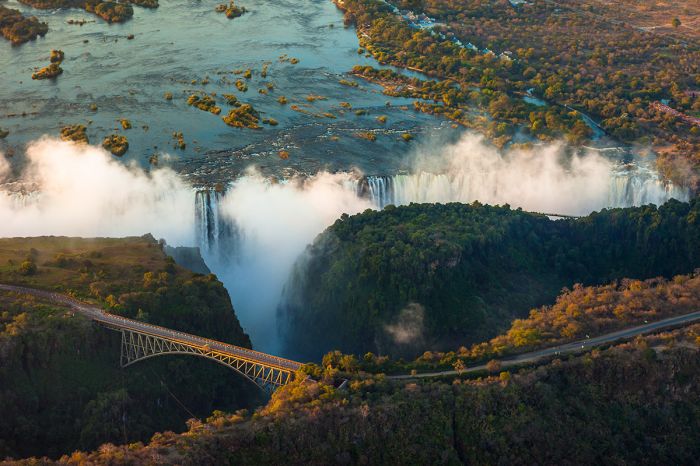
A flight above The Falls offers the best views during high water.
Helicopter Flights
Departing from Victoria Falls Town or Livingstone (Zambian side), helicopter sight-seeing flights are offered in 15- or 30-minute trips in helicopters seating 4-6 passengers. The shorter flight includes The Falls, some of the Zambezi River above the waterfall, and the banks of Zambezi National Park. The longer flight adds a trip down the gorges below The Falls.
Helicopter flights are not inexpensive, but they are a superb way to really get a feeling for the size and grandeur of The Falls, river and gorges. White-water rafting participants can also opt for a scenic helicopter pick-up from the gorge instead of a steep climb up.
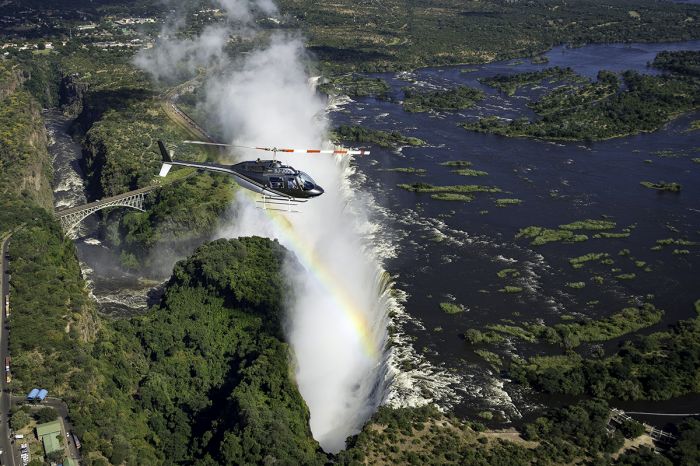
Flight of the Angels above The Falls (copyright © Batoka Sky).
Microlight Flights
Surely one of the most exhilarating experiences at The Falls is a flight in an open-air, two-seater, propeller powered microlight aircraft. These amazing machines take only the pilot and one passenger (who is seated behind the pilot) and the flights are conducted at a much lower elevation than the helicopters. Views from a microlight are wide open and uninterrupted, making it a breathtaking adventure!
Note that microlight flights are only offered from the Zambian side, but pick-ups from the Zimbabwean side are available, so this is not an impediment. The flights operate only in the morning and late afternoon in order to avoid midday turbulence. Fifteen and thirty minute flights are offered. Cameras are not permitted, but videos and images are taken remotely by the pilot and can be purchased afterwards.
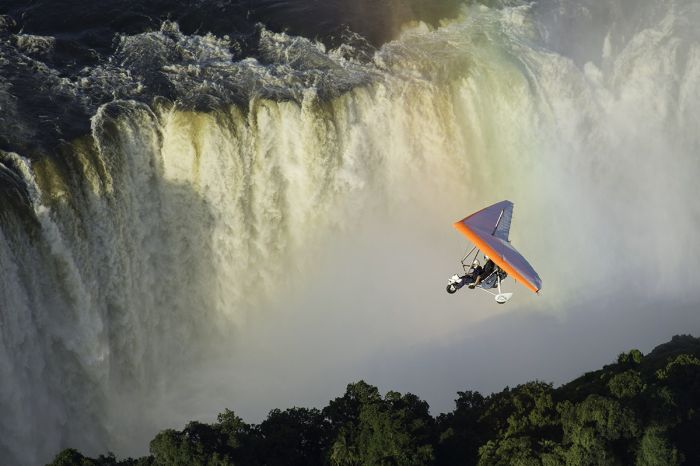
A thrilling microlight flight above The Falls (copyright © Batoka Sky).
Other Adrenaline Activities
Besides the activities discussed above, there are numerous other adventures offered at The Falls and along the gorge downstream. Popular adrenaline inducing sports and activities include zip lining, the high wire, the gorge swing, the flying fox, river boarding, kayaking, abseiling, jet boating, the bridge slide, the canopy tour, and the bridge walk.
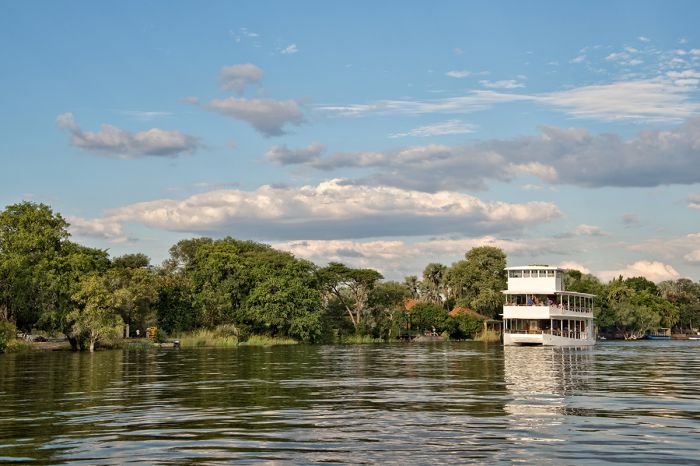
River cruises on the upper Zambezi River are a popular activity.
Protected Areas
There are three national parks protecting The Victoria Falls and portions of the Zambezi River and the gorges below The Falls. Two of the parks are on the Zimbabwean side, while Mosi-oa-Tunya National Park protects land on the Zambian side.
Portions of Victoria Falls National Park (Zimbabwe), Mosi-oa-Tunya National Park (Zambia), and a riverfront strip of Zambezi National Park (Zimbabwe), are protected as a UNESCO World Heritage Site covering a total area of 26 square miles (69 sq kms).
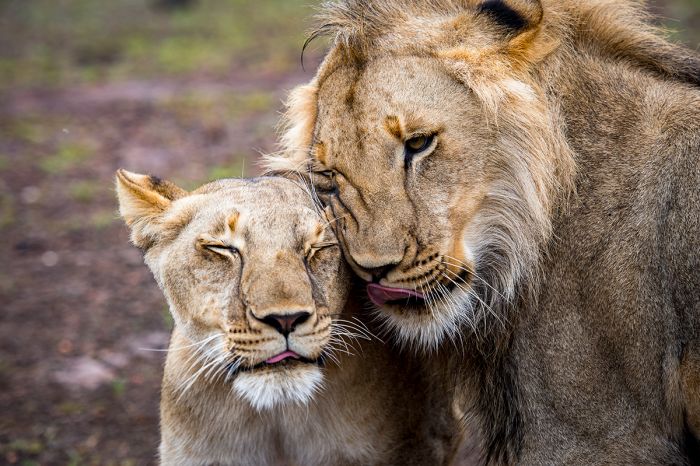
Lions are found in Zambezi National Park.
Zambezi National Park
Covering an area of 216 square miles (560 sq kms) on Zimbabwe's border along the Zambezi River, Zambezi National Park is the largest protected area in The Victoria Falls area. The park was split off from Victoria Falls National Park in 1979 and is bisected east to west by the Kazungula Road, which connects Victoria Falls Town and the border post of Kazungula (which leads into Botswana and a few miles to the north, into Zambia).
Safari drives are offered by various operators and the road network which runs along the Zambezi River is the best place to see wildlife. Animals that are commonly encountered, especially along or near the river, include elephant, buffalo, giraffe, sable antelope, greater kudu, zebra, hippo, and crocodile. Predators are also present, including lion, leopard, spotted hyena, jackal, and African wild dog.
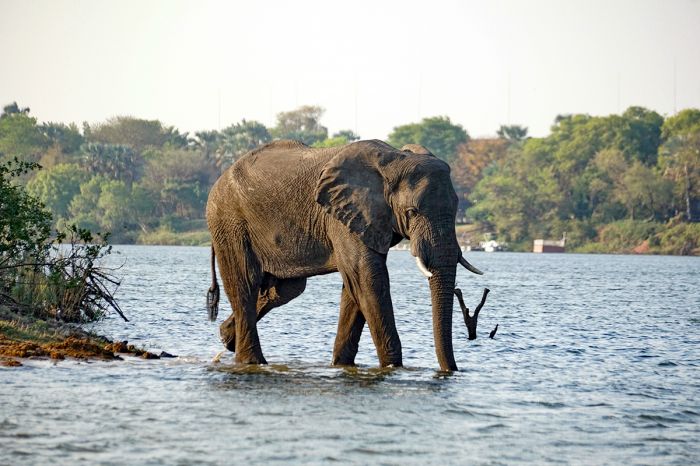
An elephant enters the river in Zambezi National Park.
There are numerous self-catering lodges spread out along the riverfront, a few self-camping sites, as well as over 20 picnic spots, which are a lovely place to stop for lunch or snacks. There are several private lodges located inside the park, offering a more upscale experience and guided activities. Self-drive safaris are permitted, but exiting your vehicle is only allowed at designated picnic sites and walking is only permitted with a park-provided guide.
The park is busiest on the weekends, as it is a popular destination for locals, but is relatively quiet during the rest of the week. The section south of the Kazungula Road (known as the Chamabonda Section) is mainly open grassland, with a few small rivers that only flow during the rainy season. This southern section is less productive for wildlife viewing.
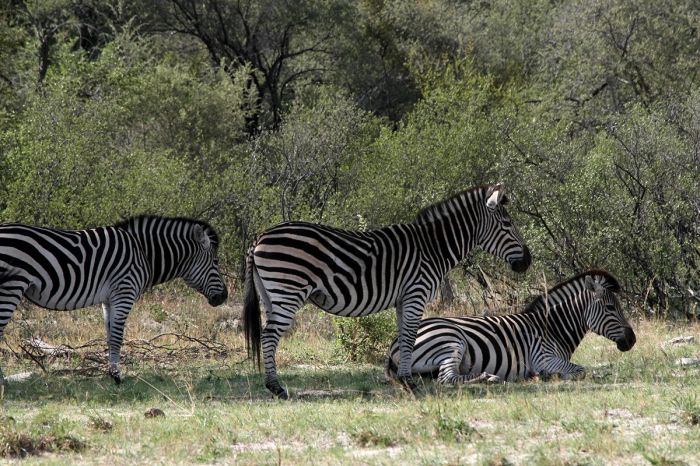
Zebras seen on a game drive in Zambezi National Park.
Victoria Falls National Park
Once encompassing the Zambezi National Park, which was split off in 1979, the much smaller Victoria Falls National Park now protects a section of land starting at The Falls and continuing south along the gorges. The most visited part of the park is the walking trail through the rain forest on the cliff opposite The Falls.
The park entrance can be reached on foot via paths from the Kingdom Hotel and Victoria Falls Hotel, as well as a path that begins opposite Ilala Lodge. The walk takes about 15 minutes and you should be prepared to be the target of endless curio sellers en route. Privately guided tours of the Falls are a good way to learn about The Falls, but self walking the footpath is perfectly safe.
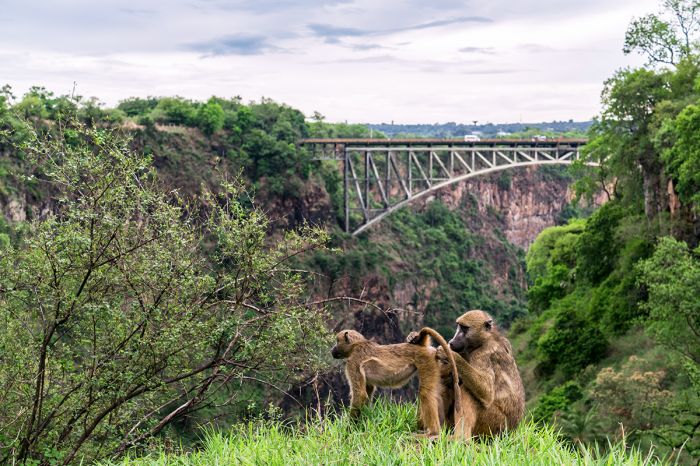
Baboons are common on both sides of the river and in the gorges.
Victoria Falls Town
With a population of between 35 000 (per latest census) to a more realistic estimate of 65 000, the compact tourist-driven town of Victoria Falls has long been one of Zimbabwe's top destinations for travelers. The town's earliest inhabitants arrived around 1900 as laborers constructing Cecil Rhodes' railway and the bridge over the gorge, which was completed in 1905. The Victoria Falls Hotel, originally built to house the railway workers in 1904, still operates today and is one of the town's historical landmarks.
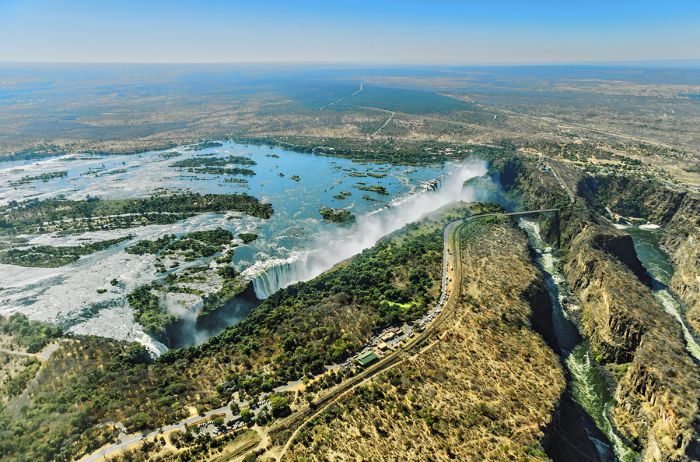
Victoria Falls Town to the right of The Falls.
The onset of adventure sports at The Falls in the 1980s resulted in a huge surge in the town's tourism. Travelers, especially young people, came for the white-water rafting, bungee jumping, kayaking, zip lining, and more.
The town's dominance as the tourism center at The Falls, took a big hit in 2000, when President Mugabe's land reform policies resulted in civil unrest and violence. Heavy media coverage worldwide led most visitors to opt for accommodation in Livingstone across the river, while Zimbabwe saw a huge decline in its tourism. Today both Livingstone and Victoria Falls Town share strong tourism revenue.
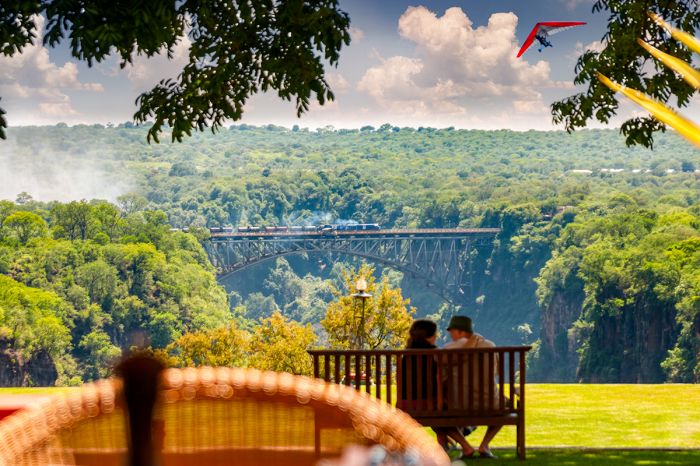
View from the lawn at The Victoria Falls Hotel.
The town offers a wide range of accommodation, including backpacker hotels, guest houses, luxury lodges, and large hotels. Outside of town, there are numerous private, all-inclusive safari lodges, including some on the banks of the Zambezi River. The town itself does not offer much in terms of nightlife or dining, with good restaurants confined to the hotels.
Victoria Falls Airport (VFA) was upgraded in 2016 with a new runway capable of accommodating long-haul aircraft. Two luxury trains, the Blue Train and Rovos Rasil offer upscale journeys between South Africa (Cape Town and Pretoria) and Victoria Falls.
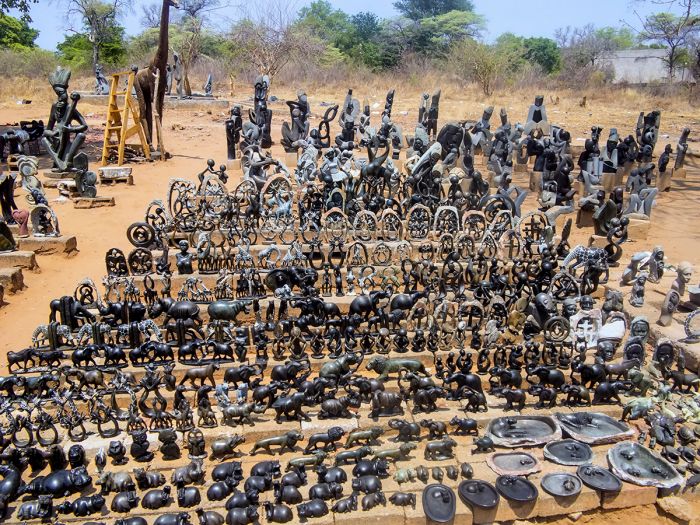
Stone carvings at one of the numerous curio sellers in Victoria Falls Town.
Read More...
Adrenaline Sports, Adventure Activities, Bungee Jumping, Canoeing, Devil's Pool, Falls Tour, Fishing, Flight of the Angels, Geological History, Gorges, Heritage Tours, High Water, Human History, Independence, Livingstone Island, Low Water, Markets & Shopping, River Cruises, Sights & Day Tours, The Victoria Falls, Victoria Falls National Park, Victoria Falls Town, Water Levels, White-Water Rafting, Zambezi National Park
Great Good Fair Poor
- Jan
- Feb
- Mar
- Apr
- May
- Jun
- Jul
- Aug
- Sep
- Oct
- Nov
- Dec
Timing your visit to Victoria Falls is important because viewing The Falls and the adventure activities on the river are different depending on the weather and in particular, the amount of water flowing over The Falls.
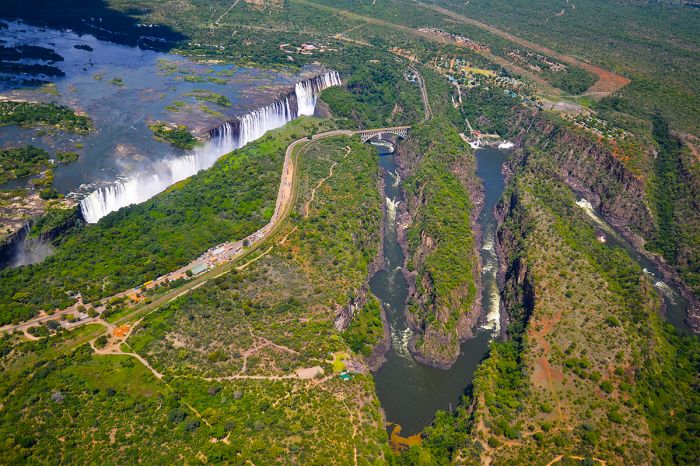
The Victoria Falls during the rainy season.
Water Levels
High Water
The amount of water flowing down the Zambezi River as it reaches The Victoria Falls is determined mostly by rainfall far to the north in the river's catchment area in Angola and northern Zambia. Local rainfall has only a minor effect on the waterfall.
Rain in the catchment area begins in December and continues through March, but this water takes weeks to flow downstream and the high water season at The Falls is typically February thru May, with the peak months being March and April.
Like most things weather related, the amount and timing of rainfall varies year to year and is never completely predictable. Beginning sometime in May, the water levels at The Falls start to decrease and continues until December, when local rains at The Falls add a bit to the river level.
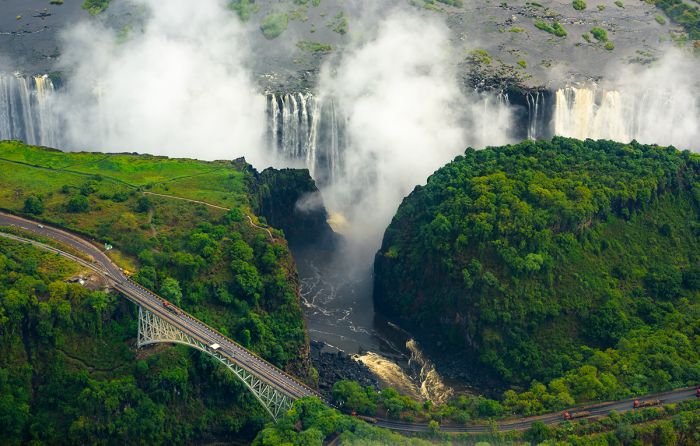
High water views of The Falls are best from the air.
During high water, actually seeing The Falls from the walking trails on the gorge cliffs is not really possible, as the amount of spray rising up from the gorge almost totally obscures the view of the actual waterfall. Nonetheless, the thundering noise of the water and the thick spray and constant rainfall makes it a memorable experience. You will need rain gear and waterproof protection for any electronics. The best way to see the waterfall at high water is on a helicopter or microlight flight above The Falls.
White-water rafting is less dramatic at high water, with less exposed rock and smoother rapids, although the currents are more dangerous. Only rapids starting after Rapid #9 are available during high water and all rafting is usually closed when the water becomes too dangerous (usually late-March thru April).
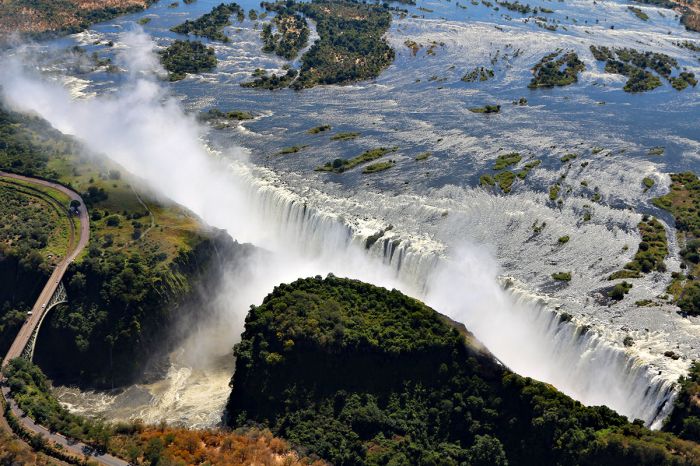
High water views are best from the air above The Falls.
Low Water
Water levels at The Falls begin receding in late April or in May and low water season is considered to be June through early December, with the lowest levels in October/November.
Starting in June, the views of the waterfall are clear from the footpaths on the gorge cliffs and by October, the water flowing over The Falls to the east of Livingstone Island becomes a mere trickle and may even dry up completely near the Zambian bank.
Views of the gorge and the rock structure at the waterfall are fabulous and the reduced spray creates excellent photo opportunities with rainbows. The popular Devil's Pool activity is only available during low water (read more on the Details tab).
White-water rafting is best during low water, with all the rapids available, more dramatic rapids, high waves and deep troughs.
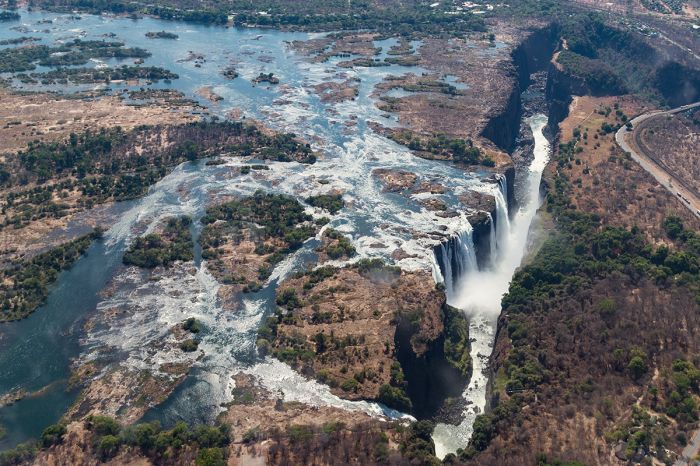
Low water at The Victoria Falls with the totally dry Zambian side.
Local Weather
Dry Season / Winter
In terms of local weather, the dry (winter) season runs from May thru October, with little to no rainfall in the area. Temperatures are warm to hot, but nighttime temps are comfortably cool. Local rainfall, which typically starts early December, is all but ended by mid-April, but the surrounding landscape retains its lush, green appearance well into May.
May temps average 80-84°F (27-29°C) with overnight temps falling to 50-54°F (10-11°C).
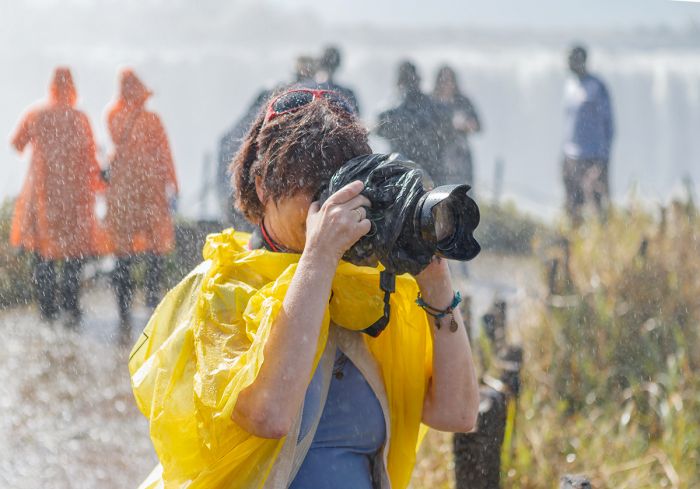
Be sure to wear rain gear and protect your camera during high water.
June and July are the coolest months of the year and are rain free. Daytime temperatures range from 77-81°F (25-27°C) and nights are cool or even chilly at 43-47°F (6-8°C). Early morning game drives or outdoor activities will require an extra layer of fleece and something to cover your ears.
August and September are dry months, but the temps are warming up. The daytime temps average 88-93°F (31-34°C) and it drops to a comfortable 46-59°F (8-15°C) overnight.
October is the hottest month, with midday temps reaching an average of 95-99°F (35-37°C), but some days are even hotter. Morning activities are recommended, with temps only around 62-66°F (17-19°C), as afternoons can be blazingly hot. Some early rainfall may come in late October, which is a welcome relief.
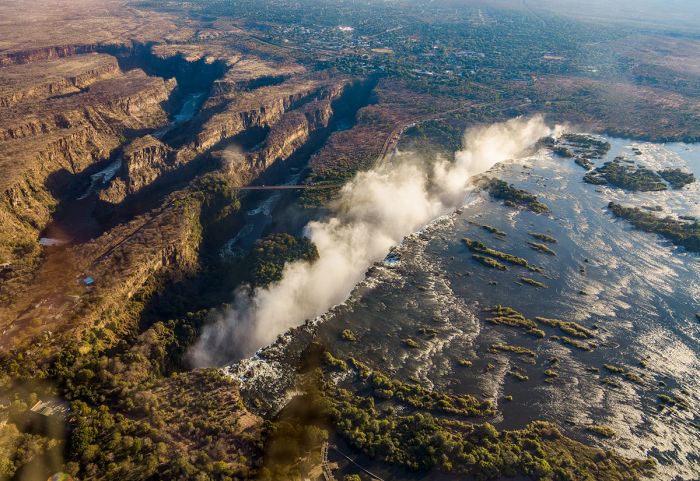
Spray rising from The Falls during high water.
Rainy Season / Summer
The rainy season near Victoria Falls is typically sometime in November thru April. The early rains bring much needed moisture after the long, dry winter and especially after the very hot and dry month of October. Rainfall typically occurs as afternoon showers and the days are humid and warm. Rains rarely last all day with the sun shining at least part of every day.
November experiences the first rains (some years in late October) and the days are quite humid, with midday temps averaging 86-90°F (30-32°C) and nighttime temps only dropping to 66-70°F (19-21°C). Afternoon showers are likely at least every other day in most years.
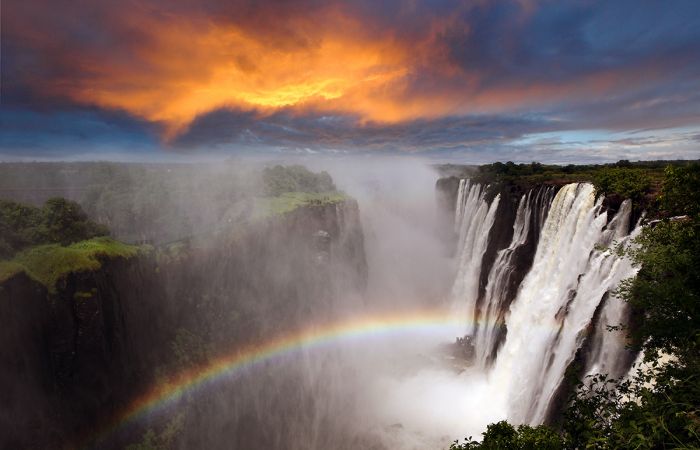
Sunset view at high water showing Knife Edge Bridge.
December thru mid-March are the wettest months, with rainfall occurring most days, but usually as short thunderstorms with intermittent sunshine. Temps during the day are warm, averaging 84-88°F (29-31°C) with overnights temps a pleasant 65-68°F (18-20°C).
April is a good month weather-wise, with only occasional rainfall and lovely temperatures and a lush, green landscape after months of precipitation. Daytime temps are a warm but bearable 85-86°F (29-30°C) and overnight temps dropping to 64-67°F (18-29°C).
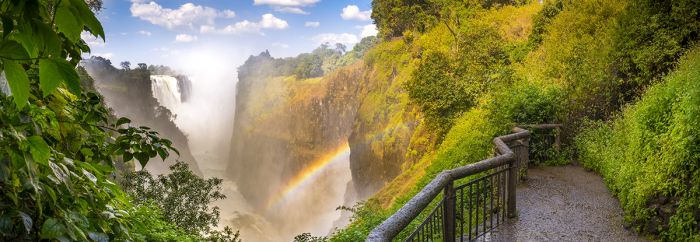
The walking paths at The Falls are usually wet, so protect your electronics!
Wildlife and Parks
Game drives are available all year in Zambezi National Park. The best game viewing is during the dry season when large mammals must concentrate close the the Zambezi River, as water holes further into the park dry up. Late July through mid-November are the prime months for wildlife, especially along the riverfront road that traverses the entire park.
Once the summer rains begin in earnest (sometime in December), wildlife disperses away from the river, as ground water provides for their needs. Birding is best in the summer (rainy season), when the migratory species return from Europe or Asia to breed. Note that the roads in the park may become very difficult after heavy rains.
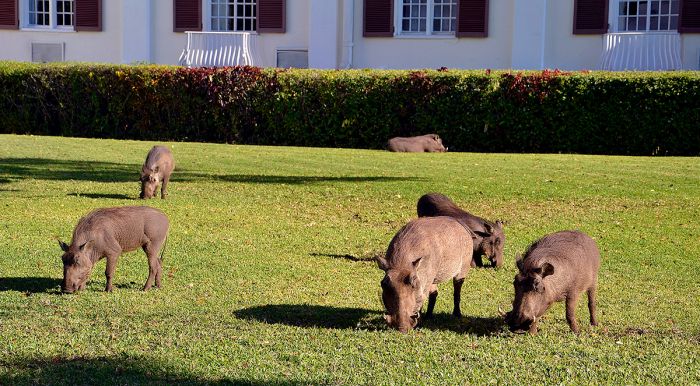
Warthogs are common on the lawns of local hotels and lodges.
Showing 1–1 of 1 results




